




DR.
JOE ÁRVAIDIRECTOR
focal points for our work






focal points for our work
When I joined the Wrigley Institute in 2020, I challenged our team to think big Bigger than any single research project, class, academic program, or even any single discipline And, wow, did Team Wrigley deliver!
Since then we ’ ve broadened the institute’s focus to include the social, behavioral, and policy sciences, as well as scholarship in business, media, communications, and the arts And we ve widened our gaze to account for a broader array of pressing environmental challenges
The Wrigley Marine Science Center on Catalina Island and L.A.’s University Park Campus continue to be the
However, the research we do, the conversations we engage in, and the students we reach are now in every corner of the Earth
In other words we ’ ve rapidly scaled up our impact on the world We’re funding more research offering more learning experiences to students, and forging more collaborations across campus and the nation to reach decision-makers in policy, business, and more
As you ll see in our first feature story, this growth has led to a branding change that reflects the wider scope of our activities It has also led to a change in our mission and vision statements These new statements both address the growth we ’ ve experienced and celebrate what is unique about the Wrigley Institute I hope you’ll find them inspiring as I do:
Every second counts The sustainability challenges we collectively face pose a clear and present threat to us and to the environment we so dearly value In light of this, the mission of the Wrigley Institute is to create a more sustainable and environmentally just future for our planet and all who live on it by:
Educating, training, and empowering the next generation of leaders and change agents
Leading solutions-focused research at the intersection of people and planet
Engaging with the public and our partners to raise awareness and inspire positive change
Thank you for taking the time to enjoy our magazine and celebrate our growth with us I hope you ll join us in our expanded mission to serve this, our one and only Earth

Cover: Environmental studies students collect data for ENST 320a: Soil and Water Sustainability The course previously offered lab and fieldwork only on Catalina Island But thanks to a recent course redesign, all environmental studies students can now participate in hands-on research (Photo: Nick Neumann/WIES)

The USC Dornsife Environmental Studies Program (ENST) started with just two core classes in fall 1993 Today, ENST has 10 core faculty and 335 students pursuing three majors and minors This year the Wrigley Institute is celebrating that 30-year journey
ENST was interdisciplinary from the beginning, says ENST Director and Associate Professor (Teaching) of Environmental Studies Jill Sohm “In the first 25 years or so, a number of ‘flavors’ of major were developed, but they continued to draw mostly on classes from other USC departments,” she says
Environmental Studies major Alisha Soni was terrified of swimming in the ocean, but she didn t want to pass on the chance to study environmental politics in the Galápagos Islands So she took the plunge figuratively and literally
In between learning about renewable energy, sustainable ecotourism, and Indigenous environmental practices, Soni plucked up the courage to face her fears and earn her scuba certification
“The program reminded me why I love environmental science so much and the opportunities that are out there for me, she says
Read more at bit ly/alisha-soni (Photo courtesy of Alisha Soni)

A 2009 curriculum overhaul gave ENST its current environmental studies major, plus more core and elective courses taught from within the program An environmental science and health major was added in 2013 Altogether, the program has graduated 947 alumni since its inception
Thanks to a closer relationship with the Wrigley Institute as well as experiential learning activities internships and research opportunities, the program continues to grow From any angle, it’s well-positioned to train environmental leaders for the next 30 years

Wrigley Institute Faculty Innovation Awards are seeding the future of sustainability research through grants that accelerate the development of new solutions to global environmental challenges
Now in their fifth year, the awards are open to all USC faculty whose original projects intersect with one of the institute s three research centers: Earth and Environmental Systems Applied Environmental Solutions and Social Transformation
“These projects have the potential to make a real-world impact for the future of our
Associate Professor of Lan Alexander Robinson sees s possibilities everywhere, e jungle
A designer of sustainable Robinson centers commun in his work. His Faculty Inn funds the capture and sha nature- and community-b solutions for the Los Ange
His collaboration with the also includes the ARCH 54 which is helping to impro and ecosystem health on t Catalina Island campus
Read more at bit ly/wiesNick Neumann/USC Wrigl
planet We’re very excited to see where the awards take them, says Wrigley Institute Executive Director Jessica Dutton
The 2023-2025 award cohort includes Earth sciences’ William Berelson (carbon capture), marine and environmental biology’s Carly Kenkel (coral reef preservation), chemistry s Smaranda Marinescu (solar-to-fuel technologies), and landscape architecture’s Alexander Robinson (restoring the L A River)
Learn more at bit ly/wies-faculty-awards
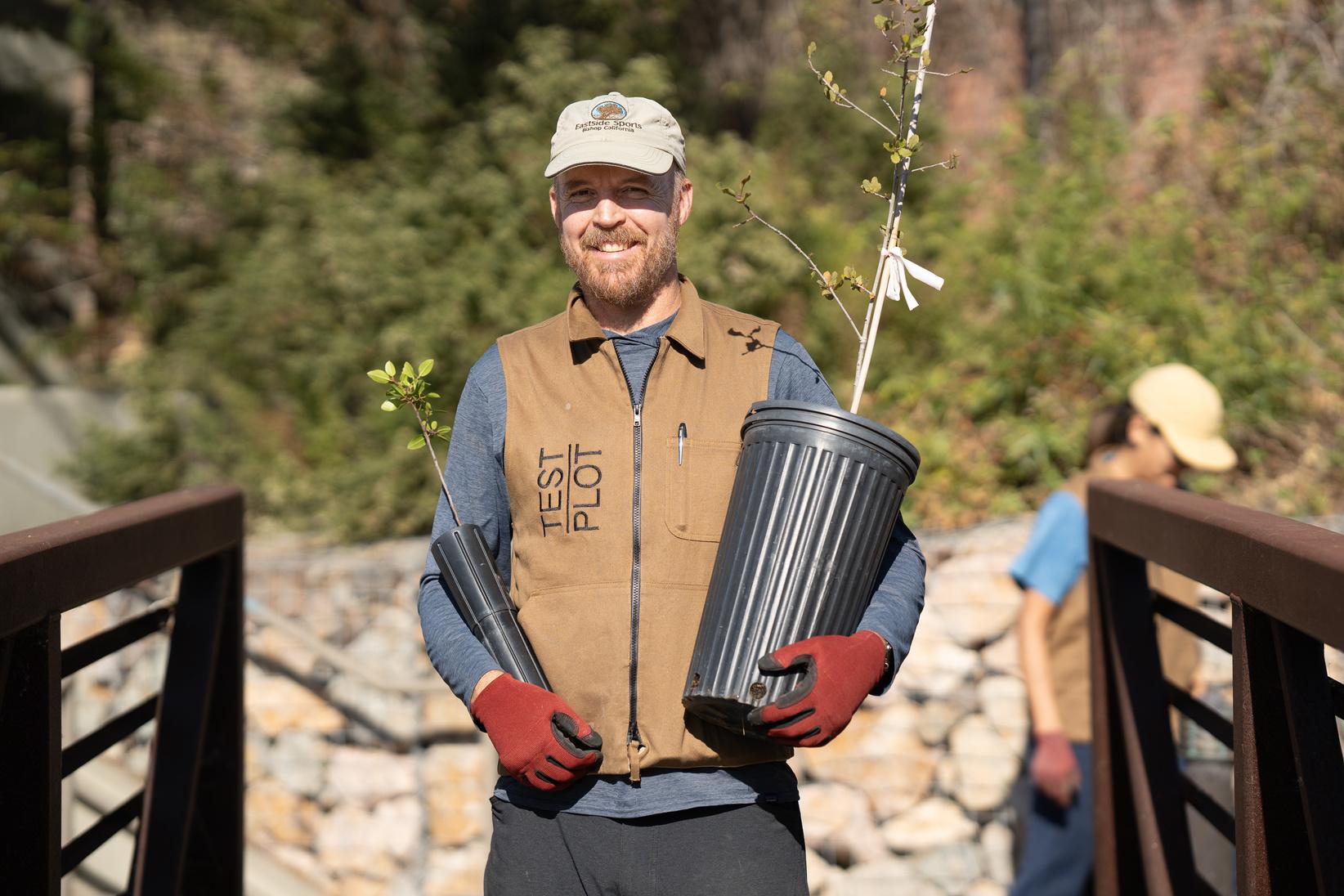
Seafood is one of the most nutritious food options our planet offers, yet low-income and food-insecure communities face tremendous barriers to accessing seafood’s benefits
The South Central Los Angeles Sustainable Seafood Hub, supported in part by the Wrigley Institute s USC Sea Grant, seeks to help solve this problem Residents in South Central L A face high rates of food insecurity poverty and disease risk Working with community partners such as Sea Grant, Holdfast Aquaculture, Santa Barbara Mariculture, and Community
Charlie Doering-Powell s most vivid childh memories are of connecting with nature, no surprise that he decided to major in environmental studies at USC
He struggled, however, to figure out his o place in the sustainability movement The landed a summer environmental communications internship with the Wrig Institute and USC Sea Grant promoting aquaculture research and the South Cent Sustainable Seafood Hub
Thanks to that experience, he says, he now knows that “being a science communicato means I can use my creativity to make the difference I always knew I could ”
Read more at bit ly/charlie-doering-pow (Photo: Nick Neumann/USC Wrigley Insti
Services Unlimited, the hub offers affordable seafood as well as cooking classes and other outreach activities to improve food equity and nutrition in the area
One such outreach event, the Sustainable Seafood Fest, took place in November 2023 Residents enjoyed cooking demonstrations, sampled seafood recipes, and learned about marine ecosystems through touch tanks and other fun activities
Learn more at bit ly/equitable-seafood

Ronald and Leslie Sherwin have made a landmark gift commitment of $50 million to establish an initiative focused on protecting the environment through research education and practice at the USC Dornsife College of Letters, Arts and Sciences Ron Sherwin is a USC Dornsife alumnus and member of the college’s Board of Councilors
“What’s important to me is that this gift will promote interdisciplinary research tied to environmental issues,” said Sherwin “It’s going to take many academic disciplines working together to help protect our environment, including psychology, spatial sciences, political science even philosophy So giving to USC Dornsife
which includes all of those as well as the Wrigley Institute for Environment and Sustainability, just makes sense ”
The initiative which will be named for the Sherwins, will fund chairs and other research projects in two areas: ecosystem conservation, some of which will fund research related to ecosystem diversity and species preservation; and research expertise in the many human factors associated with environmental protection including environmental economics, behavioral science, and political science
Excerpted from original reporting by Jim Key Learn more at bit ly/dornsifesherwins

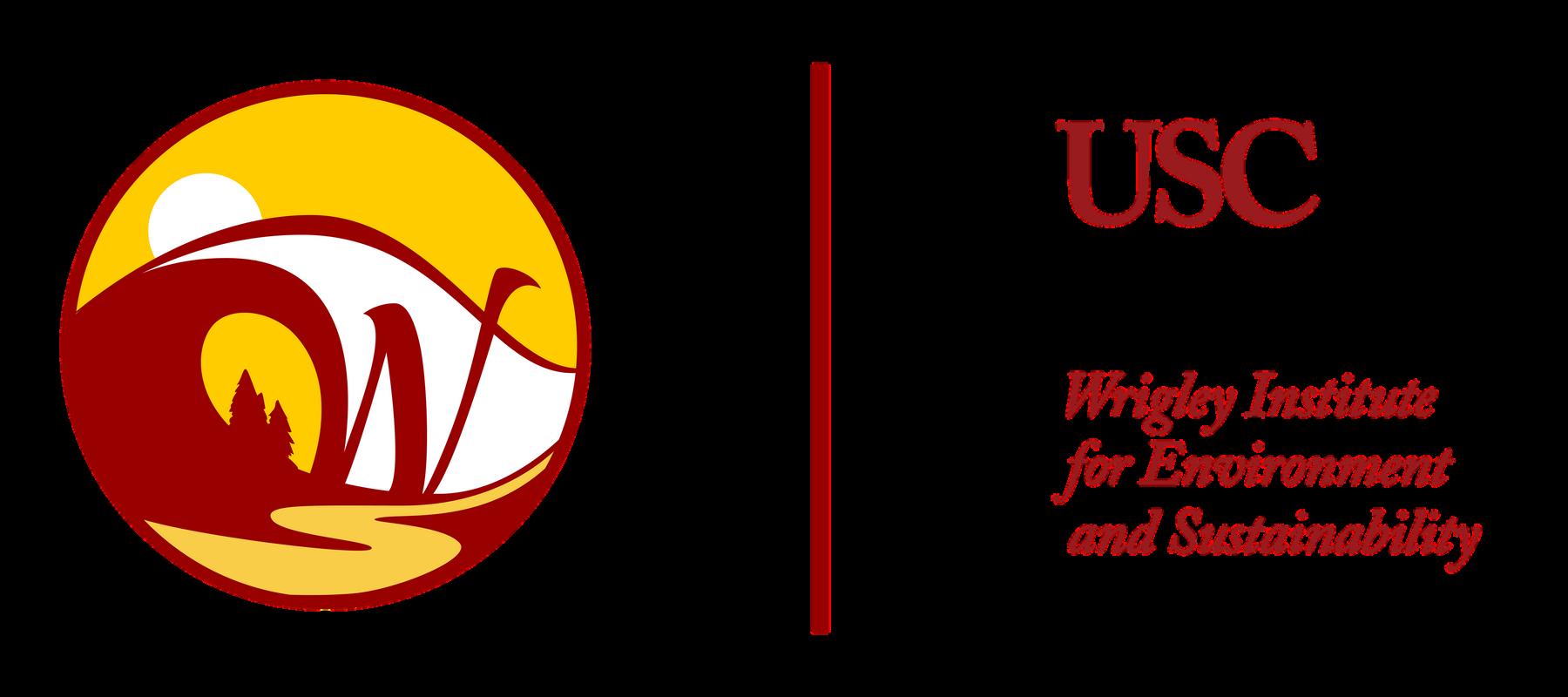 By Kathryn Royster
By Kathryn Royster
As of April 2023 we are now the Wrigley Institute for Environment and Sustainability (WIES), a renaming that reflects our long-term growth and expanded mission
“The Wrigley institute’s new name is a timely reflection of its important leadership role in environmental and sustainability education and research both at Dornsife and at USC more broadly,” says Amber D Miller, dean of USC Dornsife College of Letters, Arts and Sciences
WIES traces its beginnings to 1965 when USC broke ground on a marine research station on Santa Catalina Island, CA Located on land donated to the university
by Philip K Wrigley and his sister, Dorothy Offield, the marine station welcomed researchers and visitors interested in understanding and preserving Catalina Island’s unique marine ecology
The station became the Philip K. Wrigley Marine Science Center (WMSC) in 1990, after a series of gifts from William and Julie Wrigley led to the creation of the USC Wrigley Institute for Environmental Studies The Wrigley Institute continues to receive generous support from the Wrigley and Offield families to this day
From that point, the institute developed new programs held at WMSC; faculty awards, graduate fellowships, and other programs to support environmental research; and lectures and panels to
engage the USC community on environmental topics Between 1990 and 2020, however, WIES was still heavily focused on marine science, and for many people both within and beyond USC, the marine science center on Catalina Island was the Wrigley Institute
The Wrigley Institute’s new name is a timely reflection of its important leadership role in environmental and sustainability education and research both at Dornsife and at USC more broadly.
Amber D Miller, Dean, USC Dornsife College of Letters, Arts and Sciences
That all began to change in 2020 as USC and Dornsife College sharpened their focus on sustainability in all its forms Dr Joe Árvai, an oceanographer-turned-behavioral psychologist, was appointed to lead WIES and began the task of guiding the institute into its next era
“Both [USC President] Carol Folt and Amber Miller had a really exciting vision for how the Wrigley Institute could become a more integral part of our shared commitment to sustainability leadership in California and around the world ” Árvai says “I could see on my first day that we had a deep bench of sustainability-focused talent, including an amazing interdisciplinary team within the Wrigley Institute It made perfect sense to expand the institute’s focus so that it could better complement the other terrific work being done across USC and Dornsife.”
Since questions of environment and sustainability touch every aspect of our lives and because they unfold in every corner of our planet, WIES has broadened its programs to include international research and to embrace a much wider array of disciplines across the natural and social sciences, humanities and the arts
For instance, in 2021, the institute added an environmental communications internship to complement its natural and social science research internships The 2024 Wrigley Institute Graduate Fellows cohort includes Dornsife Ph D students from the fields of chemistry marine and environmental biology Earth sciences, history, sociology, economics, classics, and more Wrigley Institute faculty are conducting research in California and on every single continent And WIES has added USC Dornsife’s Environmental Studies Program and a new online master’s degree in sustainability management, making the institute a degree-granting unit for the first time
“It had been my family’s vision all along that the Wrigley Institute be home to internationally recognized educational and research programs that aim to address the world’s most pressing sustainability challenges,” Alison Wrigley says The institute s new name, and its great progress over the last several years, reflect that vision ”
Julie Wrigley agrees. “Having watched the progress of the Wrigley Institute over nearly five decades, it has been amazing to see the changes brought about over the last few years under the leadership of Amber Miller and Joe Árvai ” she says “When it comes to sustainability research education and engagement, they have led the Wrigley Institute into the twenty-first century “


Thirty years ago, the USC Dornsife Environmental Studies Program (ENST) was established with an important mission in mind: to train the next generation of creative and effective environmental leaders who will address our planet s complex challenges
The program which is now part of the Wrigley Institute, engages students in coursework that taps into the natural sciences and social sciences, equipping them with knowledge and skills to tackle the interdisciplinary nature of today’s environmental problems
ENST faculty are teaching faculty, meaning that they focus primarily on mentoring and instructing undergraduate students This arrangement, combined with
the interdisciplinary curriculum and students’ access to the Wrigley Marine Science Center on Catalina Island creates a transformative experience for many students
Upon graduation, environmental studies alumni are prepared to embark on a wide range of professional journeys – from pursuing graduate studies in sustainability fields to launching careers in applied science, environmental policy conservation and more
Keep reading to learn, in alumni’s own words, how their environmental studies degrees and time spent with the Wrigley Institute propelled them toward meaningful work in diverse fields around the country
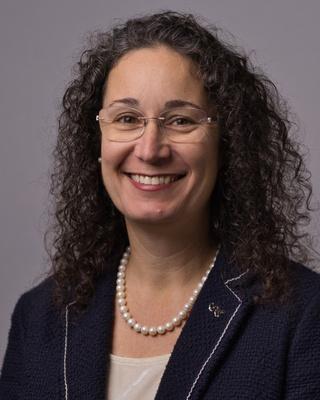
Dr. Sharon Walker ‘98
Dean and Distinguished Professor of Civil, Architectural and Environmental Engineering, Drexel University College of Engineering
“My time on Catalina Island was the defining intellectual and personal experience of my college career Admittedly it taught me how difficult field research is and influenced my choice to do labbased research in my own career Nonetheless, I loved the livinglearning environment As we were the first residential class out at the Wrigley [Marine Science Center] in spring 1998, I appreciate the wonderful faculty and staff who worked hard to make it happen ”

Miguel Ordeñana ‘05
Community Science Senior Manager, Natural History Museum of Los Angeles County
“I have been passionate about wildlife conservation my entire life but struggled to envision myself as an environmental professional because I came from a background underrepresented in the field ENST nurtured my passion while challenging me to consider the various physical and social factors that impact wildlife, humans of all backgrounds, and our ability to coexist It placed wildlife conservation into a more relevant context for someone like me and helped make a career in wildlife conservation seem more tangible
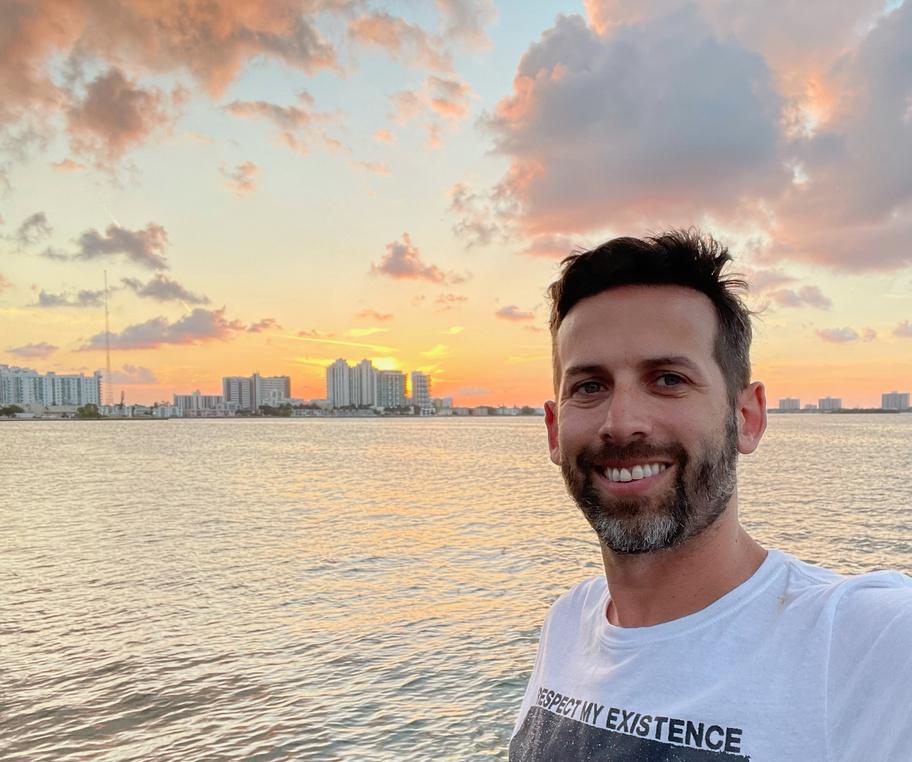
Justin Pearce ‘15
Fishery Management Specialist, NOAA Fisheries
“If it wasn’t for the Wrigley Institute I don’t think I would’ve found my career path as easily as I did I first learned about our federal fisheries management in my Introduction to Environmental Studies class My work in that course opened my eyes to applied science and natural resource management concepts that put me on the career path I’m on today ENST courses in marine policy, ecology, resource economics law and scientific diving (in Palau!) were also pivotal to my education and career Not to mention, I made lifelong friends while I was there ”
 Caitlin Hoversten ‘18 Federal Account Manager, Esri
Caitlin Hoversten ‘18 Federal Account Manager, Esri
“Being versed in business from an environmental perspective and having a GIS background from ENST has been pivotal to my career I would not have been able to step into this role without [that experience] The ENST program at USC was my home I was a student assistant after transferring to USC and I grew close to all the incredible professors that [environmental studies] is so lucky to have I am deeply grateful for the years I spent with ENST, the memories I made and the forever family I gained through such an incredible program
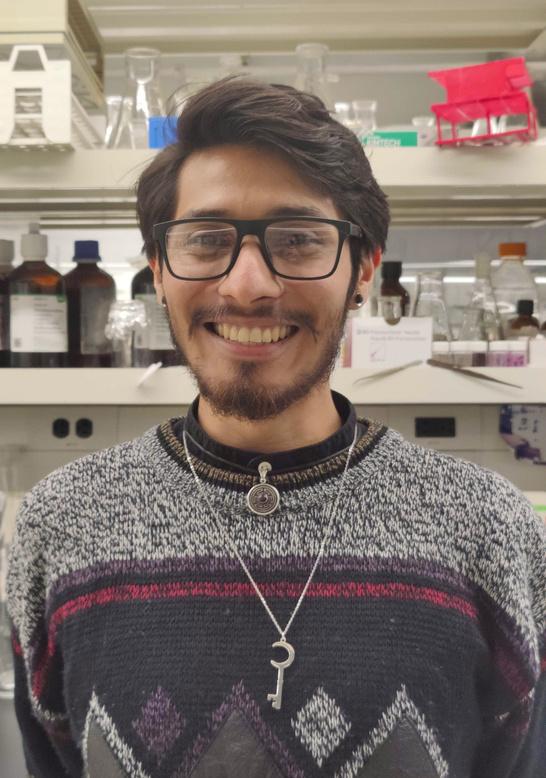
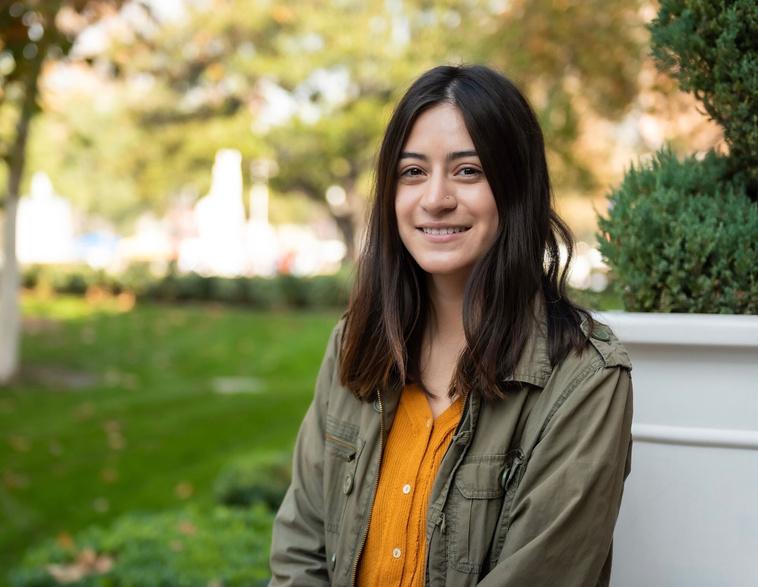
Efrain Vidal ‘19
Ph D Student (Chemistry), University of Oregon
“Because of the interdisciplinary nature of ENST, I was exposed to organic chemistry and that led me to pursue a deeper understanding of the subject And reading scientific publications and doing a lot of group work in my ENST classes really helped prepare me for the nature of research in a chemistry lab This program is a major catalyst in my eyes There are so many paths that ENST students can find themselves on, and the faculty are real stars both for encouraging students to follow their interests and in assisting them to prepare for their professional lives beyond USC
Connie Machuca ‘20 Biological Science Technician, USDA Agricultural Research Service
“My experience with ENST and the Wrigley Institute REU program helped me solidify my goal of becoming a research scientist [It] allowed me to gain scientific research experience while understanding the importance of policy and regulation within sustainability and environmental research I really enjoyed the support and guidance given by ENST faculty and Wrigley Institute staff Everyone was always willing to talk about their experiences and provide students with opportunities and resources ”
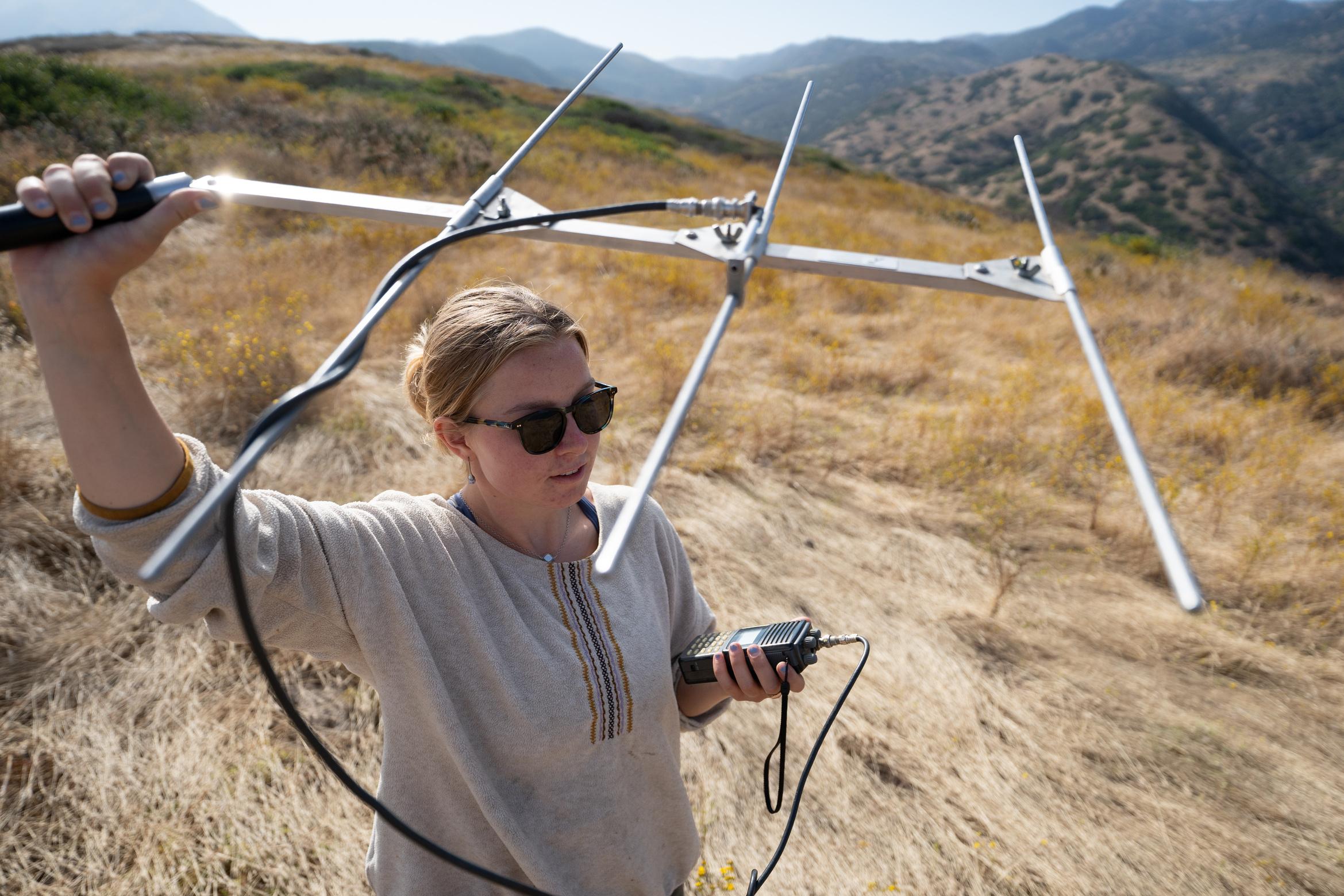
Audrey Stavish, a USC environmental science and health major and marine biology minor, uses an antenna to listen for signals from radio-collared animals Through a Wrigley Institute-funded internship, Stavish spent summer 2023 living on Catalina Island and working with the Catalina Island Conservancy on projects related to native plant and animal species She helped monitor the Catalina Island fox population, remove invasive plants, re-introduce native plants such as the malva rosa, and more “Being here and learning how things work is helpful to contextualize what conservation actually looks like,” said Stavish See the photo essay about her summer on the island at bit ly/stavish-internship (Photo: Nick Neumann/USC Wrigley Institute)

A typical early summer morning at the Wrigley Institute’s Wrigley Marine Science Center waterfront is a tranquil sight The waves of Big Fisherman Cove ebb and flow, gently nudging floating kelp closer to shallow waters Great blue herons which nest in the cliffs next to the water, quietly hunt for breakfast as bright orange Garibaldi fish dart in and out of the rocky reefs along the shore
On a recent July morning, however, the view was different A small group huddled together at the dock, a palpable sense of urgency filling the air as they cheered loudly for two figures in the water
Angelo Spinosa, a student in the institute’s annual Scientific Diving Discovery Program (SDDP) was retaking his swim test for the sixth time Jordyn Scott, another diver-
in-training, was in the water to provide moral support and help Spinosa maintain his pace
As part of the month-long SDDP, students from underrepresented backgrounds complete training on the fundamentals of scuba diving and underwater research For Spinosa, who navigated financial challenges while moving 13 times over the course of his educational career, the high cost of equipment and training had made scientific diving seem more like a lofty dream than an attainable achievement
When he heard about the SDDP through a professor at L A Valley College, he jumped at the opportunity He was determined to get certified in scientific diving before starting classes as a marine biology student at California State University Long Beach
Although the SDDP removed the financial barriers Spinosa was facing he quickly realized that he’d have to overcome another challenge: gaining the physically demanding water skills necessary for scientific diving
“The greatest barrier dive students face, besides finances is the swim evaluation ” says USC Diving Safety Officer Hanna Reed who is also the SDDP’s lead instructor. “There are so many barriers associated with swimming, reflected in racial and ethnic disparities in drowning rates and lack of exposure to swim lessons You can just imagine why it’s so emotionally charged ”
As Spinosa fell behind, his peers stepped up their encouragement
Scuba diving is an inherently dangerous activity so divers must prioritize their physical safety while they’re in the water. For the SDDP students, however, psychological safety was equally important, given that being underwater for extended periods of time while conducting research was largely unfamiliar territory Reed and the rest of the program team knew that an environment of trust, vulnerability, and mutual support would be key to the students’ success
This year, Wrigley Institute Engagement Coordinator and 2022 SDDP alumna Marcela Riddick organized team-building activities and workshops for the students to learn how they could leverage their new skills in their academic careers and beyond
Without opportunities and programs like this, I wouldn’t have any chance of getting an extended education, especially in something like scuba It’s brought me a much deeper connection with the ocean Scientific Diving Discovery Program student Angelo Spinosa
“Keep going!”
“You’re so close!”
Just a little more!
Jordyn Scott swam ahead, beckoning Spinosa forward With a look of relentless determination, Spinosa kept going until he reached the dock for the final time Moments after touching the finish line, he learned that he had completed the swim five minutes quicker than his initial time With the support of his peers he had finally passed the test
“Moral of the story: even when you feel like giving up, you ’ ve got more fight in you, ” Spinosa said
Outside of the water students bonded through dining hall mealtimes where they excitedly recapped what they saw in their daily dives and shared their new personal achievements The cohort took frequent group trips to the nearby town of Two Harbors and attended karaoke nights and outdoor excursions planned by the Wrigley Institute’s education team.
The students’ camaraderie with each other and the program team helped them successfully complete physically and mentally demanding training simulations These included dives that involved task loading (the accumulation of scuba activities beyond swimming, breathing, and monitoring one ’ s air) or buddy breathing, a rescue
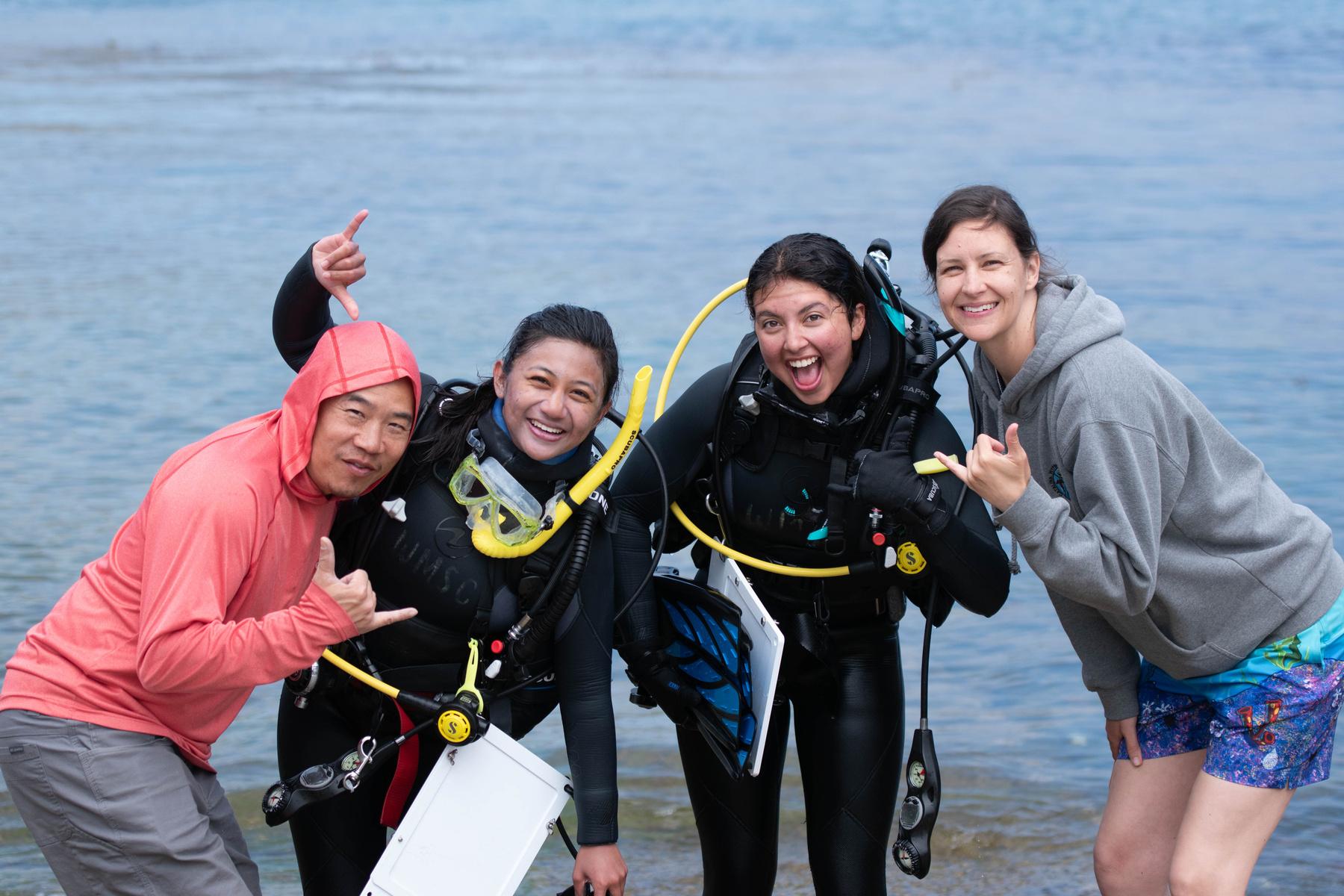
technique that requires two divers to share one regulator
Before each dive, students were given the opportunity to speak up about anything that made them feel intimidated or uneasy The dive team in turn addressed questions and issues, and reassured students that they were in a controlled environment
“I think the lesson they learned is when and how to advocate for themselves,” said Reed
By the last day of the program, every trainee had successfully completed more than 25 dives And all seven participants earned their American Academy of Underwater Sciences (AAUS) diving certification, a prerequisite for most internships careers and graduate study in ocean science and related fields
“Without opportunities and programs like this, I wouldn’t have any chance of getting an
extended education, especially in something like scuba,” Angelo Spinosa said “It’s brought me a much deeper connection with the ocean
The Scientific Diving Discovery Program is funded through the generosity of annual donors and is currently seeking dedicated funding
Scan the code with your smartphone’s camera to watch a video story on the SDDP!

Students enrolled in the 2023 Wrigley Institute Catalina Residential College learn how to take transect measurements, a key skill in scientific research These students were collecting data about Catalina Island’s tide pools and intertidal zone Located just 22 miles from the Los Angeles metroplex the Wrigley Institute’s Catalina Residential College at the Wrigley Marine Science Center provides a unique opportunity for students to compare and contrast a pristine preserved ecosystem with one that has been heavily affected by human activity Immersive learning takes place across topics and disciplines, including marine biology, ecology, archaeology, island history, and more
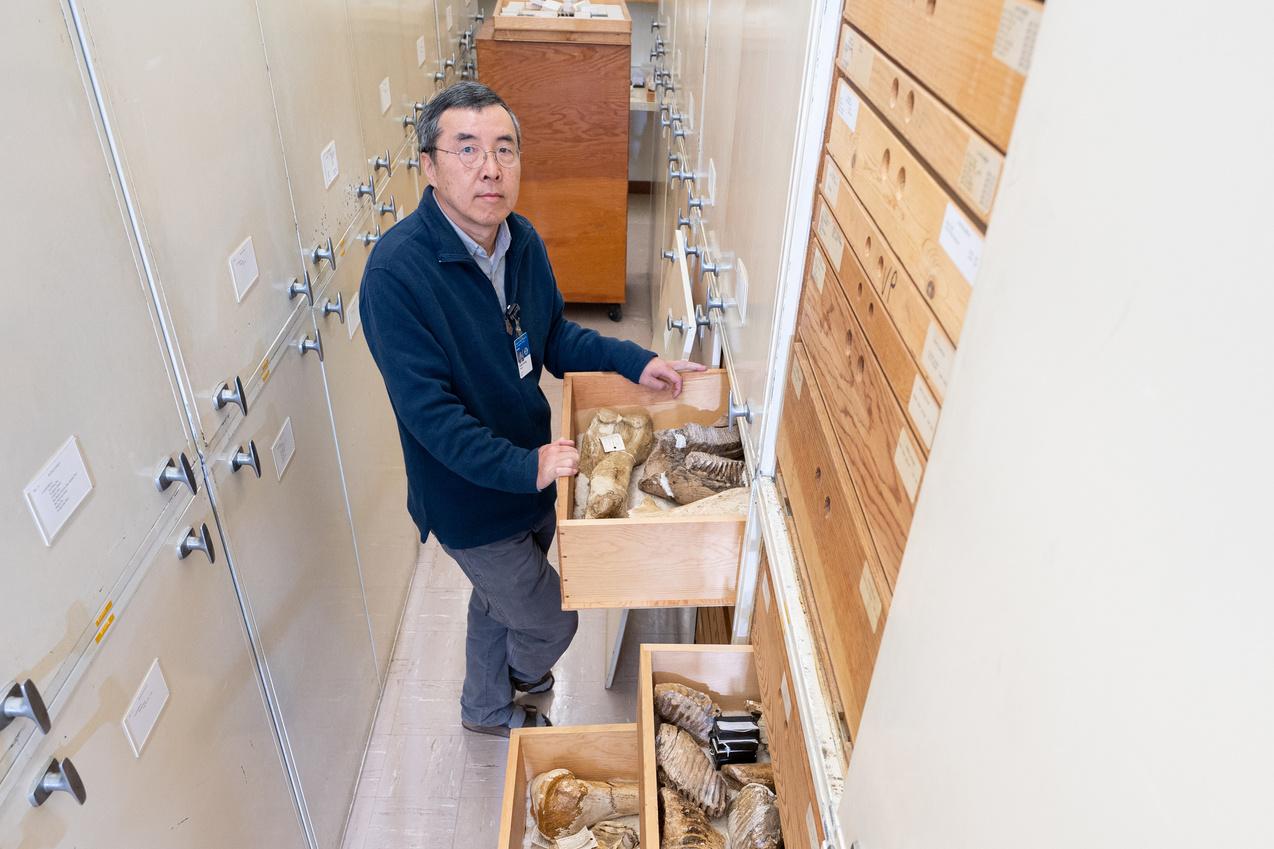
Xiaoming Wang, a curator for the Natural History Museum of Los Angeles County, with fossils from dwarf mammoths that once lived on California’s Channel Islands Wang and USC researchers are using insights gleaned from the fossils to illuminate the history of the Channel Island fox, whose full-size ancestors (like the mammoths’) evolved into a smaller species after arriving on the islands (Photo: Nick Neumann/USC Wrigley Institute)
By Kathryn RoysterToday 22 miles of water separate Santa Rosa Island (one of six large Channel Islands) from mainland Southern California But 20,000 years ago, the distance was much shorter An ice age had sucked up much of the ocean ’ s water into a massive
ice sheet on the northern continents causing a drop in sea levels of about 400 feet, and only about 5 miles of water separated the land masses on either side of what is now the Santa Barbara Channel
Five miles happens to be a very reasonable distance for elephants to swim – which according to Natural History Museum of Los Angeles (NHMLA) Curator and Chair of Vertebrate Paleontology Xiaoming Wang, is why Santa Rosa is littered with mammoth fossils The animals likely swam to Santa Rosa at some point during the ice age and conditions on the island were favorable enough that they stayed.
The fossils from Santa Rosa, however, highlight a twist to the story: the swimming mammoths’ descendants gradually shrank in size and became a new species Santa Rosa’s dwarf Mammuthus exilis (literally, “exiled mammoth”) was only 5-6 feet tall, about half the height of its mainland ancestors
Wang has studied Mammuthus exilis extensively, and he says the animal’s story is a prime example of what scientists call the “island effect” or “island rule”: “If an animal that comes to an island is roughly larger than a breadbox, their descendants tend to shrink their body size because the island resources are limited compared to the mainland This happened with the island mammoths over a fairly fast span of time,” Wang says
Santa Rosa’s mammoths died out at the end of the ice age about 11,000 years ago, but that island and the five other large channel islands are now home to another animal that evolved under the island rule: the Channel Island fox (Urocyon littoralis), a smaller relative of the mainland gray fox (Urocyon cinereoargenteus)
Wang is a specialist in the evolution of fossil canids (dog-like carnivores including foxes) and with the support of the Wrigley Institute he and USC Dornsife Professor of Biological Sciences Suzanne Edmands have been working together for almost 15 years to uncover clues to the evolutionary history of and effective conservation strategies for the island fox

A Catalina Island fox naps in a tree at the Wrigley Institute’s Catalina Island campus There are six subspecies of Channel Island fox, each named for the island where the animal lives The foxes are the largest native mammals on the islands and, as such, are considered apex predators and keystone species Due to the large numbers of visitors to Catalina Island, that subspecies of fox is especially vulnerable to threats such as disease, injury, and habitat loss
Their collaboration is unusual because, while Edmands focuses on conservation genetics, Wang focuses on morphology (body shape and size) The two disciplines don’t typically work together which means that researchers like Edmands often don’t know how the genes they’re studying relate to animals’ evolutionary adaptations, and researchers like Wang often aren t aware of the molecular or genetic mechanisms that affect morphology
The two scientists want to bridge those gaps because they believe that in doing so they’ll be better able to support conservation and management of what Edmands calls “ a very unique and threatened species ”
The Channel Island fox is in a perilous position due to an outbreak of canine
distemper and increased predation by golden eagles in the 1990s These pressures brought the species to the brink of extinction, but thanks to intensive conservation work, it has since been upgraded to “ near threatened status Because the current population was rebuilt from very low numbers however the foxes currently living in the Channel Islands have very low genetic diversity This makes them potentially more vulnerable to threats such as disease, physical weakness or deformities, and environmental changes
There is some good news however In the first phase of their research, Wang, Edmands, and then-USC Dornsife Ph D student Nicole Adams 19 dug deeper into the molecular side of things They used tissue samples from the NHMLA’s collection and fox feces collected in the wild to study the bacteria in the fox’s gut (its microbiome) and the portion of its genes that are actually expressed (its exome) They found that, although exome diversity in the fox population is low and has declined further since the 1990s, the animals have reasonably good diversity in their gut microbiome
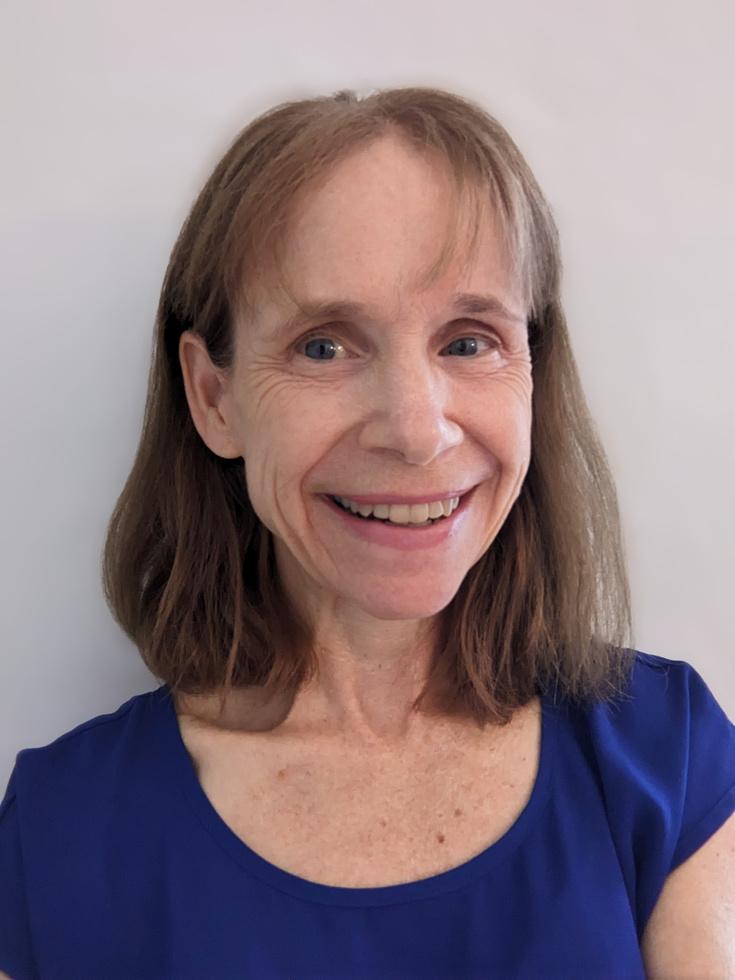
“The gut microbiome is super important in immunity and general health It could be an alternate way for the foxes to deal with environmental changes,” Edmands says
In the current research phase Edmands and Wang are working with USC Dornsife marine and environmental biology Ph D student Kimberly Schoenberger to investigate how the fox may have ended up in the Channel Islands in the first place
Based on the fossil record, scientists believe that mainland gray foxes first came to the northern Channel Islands 6,00-8,000 years ago and reached the southern islands later Unlike the mammoths, the smaller foxes would have been unlikely to swim the channel which grew wider after the ice age ended Wang says, however, that the foxes could have “rafted” over by clinging to floating objects, such as pieces of wood They might also have arrived with Indigenous people, who developed thriving settlements in the Channel Islands during that period
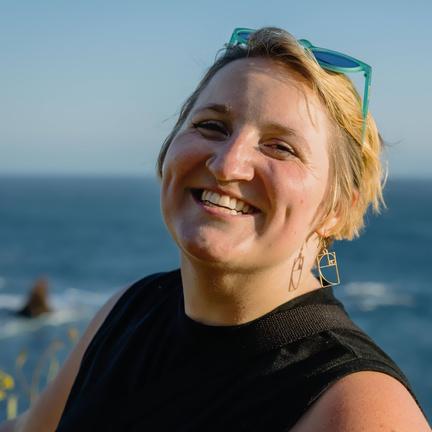
gy professor Suzanne Edmands (left) has Wang (pictured at beginning of story) for h into Channel Island foxes Marine and environmental biology Ph D student Kimberly Schoenberger (right) recently joined the two in their efforts to uncover insights that support the conservation of this threatened species (Photos courtesy of Suzanne Edmands and Kimberly Schoenberger)
Working with NHMLA specimens, Schoenberger is comparing morphological differences between mainland gray foxes and island foxes She uses CT scans to create 3D models of the two species skulls, then measures the skulls’ interiors and exteriors Because mammals’ brains generally grow to fill the insides of their skulls, she can use the interior data to generate a model of the brains, which are not preserved in historic samples These “endocasts” can be used to examine the shape of the brain and to determine how large the two species’ brains are in comparison to their overall body sizes
“Through either domestication or adaptation to island life, larger mammals often develop a smaller brain size because the brain is a very resource-heavy organ, and there has to be a reason to maintain it,” Schoenberger says “If the animal doesn’t need that same cognitive capacity to evade predators or hunt for prey they might evolve a smaller brain size compared to the rest of their body By comparing how brain size changed as the
island fox evolved, we can infer a lot of additional information about how and why that might have happened.”
The tools used for this work are cutting-edge in paleontology but already somewhat familiar to Schoenberger, who worked as a 3D video production specialist for a biotech company before going back to school to study biology. She especially likes the technology-based approach because it allows her to take measurements and cross sections of the skulls without damaging them
Morphological data alone won’t tell Schoenberger Edmands and Wang everything they want to know about the island fox’s evolutionary journey But when the morphological data is combined with genetic data, a more complete picture can emerge
“Foxes are closely related to domestic dogs, which are really well-studied Dogs are a great reference point because there are breeds that have been artificially selected for

Ph D student Kimberly Schoenberger looks through brain models she’s made using CT scans of fox skulls The models will help researchers determine whether the island fox’s ancestors were ever domesticated (Photo: Nick Neumann/USC Wrigley Institute)
certain characteristics, and then there are ‘village dogs [dogs that are not pets, but live in or around human settlements] that are less selected ” Edmands says
Researchers have identified the functions of a wide variety of dog genes, including genes that affect insulin processing, skeletal formation, body size, and tameness – all traits that are useful in assessing the survivability of a species Edmands can look for those same genetic markers in the island fox and use molecular changes to determine whether the genes have actually been expressed in the fox, or are dormant parts of its genome She can even estimate when and how rapidly a th
tendency to do something that is comfortable We want to breach the comfort zone and train our students to be comfortable with both approaches ” he says
Since its rebound from the catastrophe of the 1990s, the fox population has remained healthier than expected Ultimately, Edmands, Wang, and Schoenberger are looking to uncover why that is the case Are there specific characteristics of the fox’s genome that help outweigh the overall lack of genetic diversity? Is its microbiome a factor? Have the nature and timing of morphological changes worked to the fox s benefit? Or is it all of the above? The answer more than just the c h
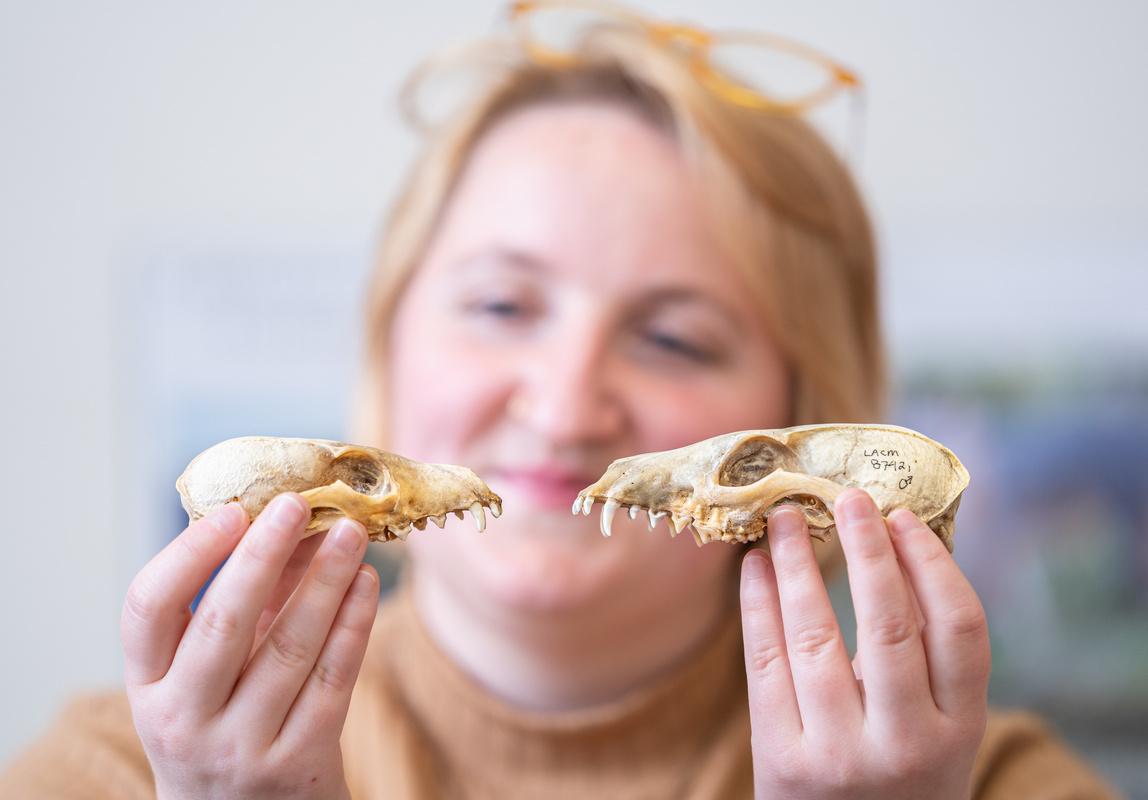
current state on their own or as a result of domestication
The strength of this cross-disciplinary approach is partly what fuels Wang’s enthusiasm for the trio s work
“This project is great because we ’ re training students who are exposed to the natural history collections or morphological pursuits, and then we ’ re also encouraging students to broaden themselves to get the DNA side of the connection Science has a disciplinary
Ph.D. student
Kimberly Schoenberger compares an island fox skull (left) with the skull of a mainland gray fox The relative sizes and shapes of the skulls hold clues to the species’ histories (Photo: Nick Neumann/ USC Wrigley Institute)
eographically assess the implications of long-term small population size ” Schoenberger says “A lot of conservation efforts are based on protecting these small populations, so when we look at these factors for the island fox, we can potentially inform conservation efforts for other species ”
The research highlighted in this story was originally published in Molecular Ecology It was funded in part by a grant from the Offield Family Foundation through the USC Wrigley Institute for Environment and Sustainability and by USC Dornsife College of Letters, Arts and Sciences.
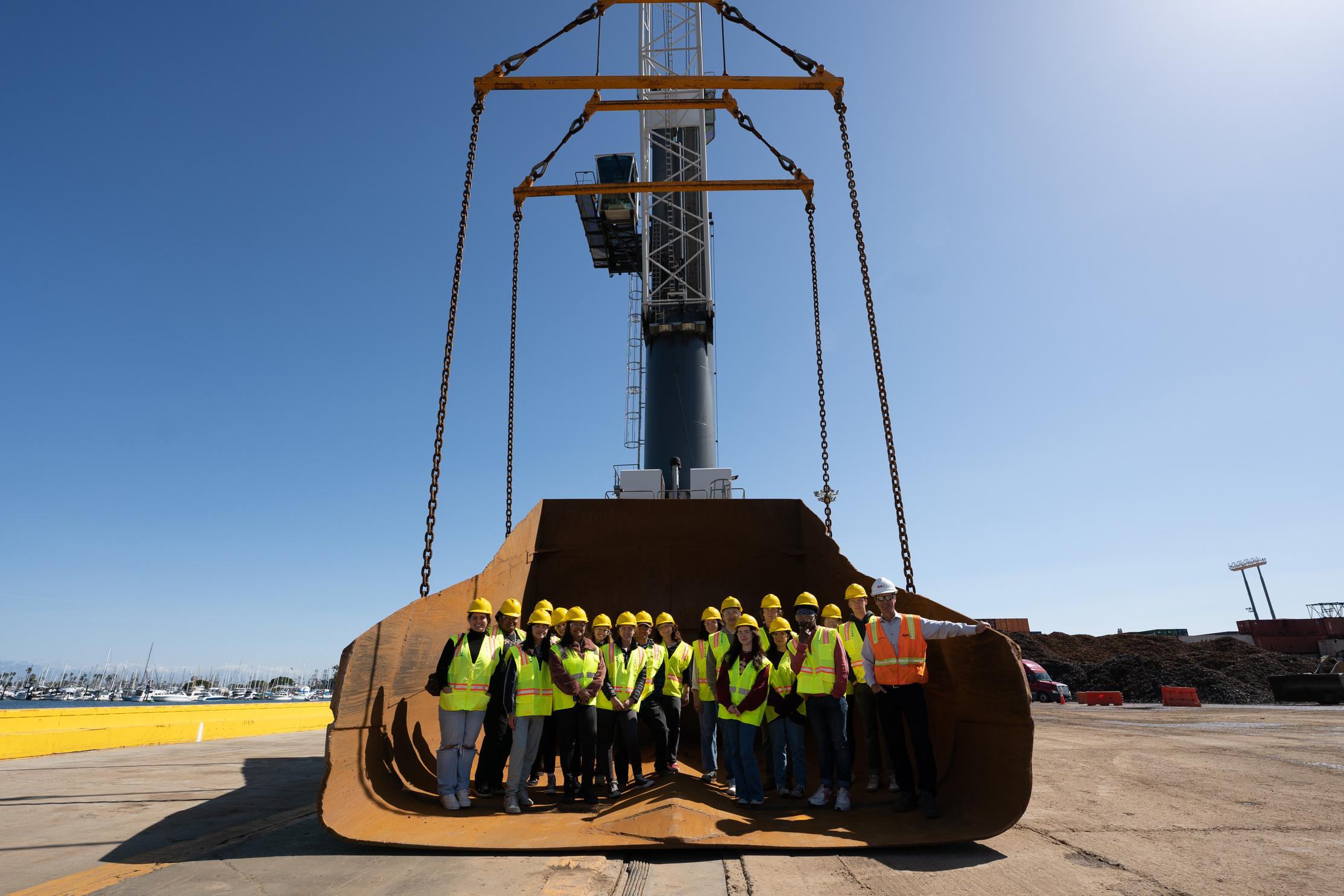
Students from an environmental studies course on the economics of sustainability pose with Wrigley Advisory Board member Terry Adams (far right, in orange vest and white hard hat) during a visit to SA Recycling Adams, who is a director at the company, welcomed students to SA Recycling’s San Pedro facility for a firsthand look at the mechanics of recovering and recycling metals Students also learned how the company assesses and makes decisions about the relative costs and benefits of processing various types of materials. (Photo: Nick Neumann/USC Wrigley Institute)
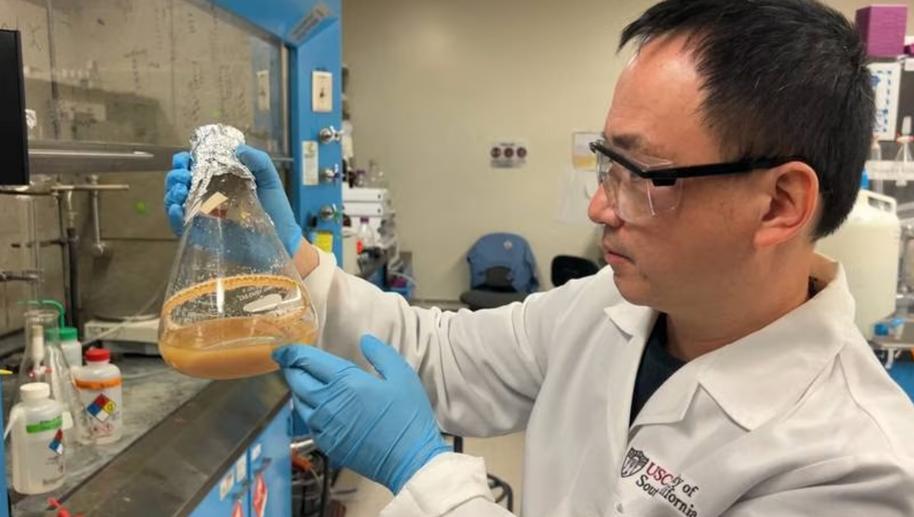 By Paul McQuiston
By Paul McQuiston
A Wrigley Institute-supported project tackling a seemingly insurmountable problem - plastic garbage in the Pacific Ocean - illustrates the ambitious Trojan approach to sustainability research
One of the world s most devastating examples of plastic pollution sits just off
the L A Coast, in Catalina Harbor The harbor s beach captures trash from the massive Great Pacific Garbage Patch, a gigantic swirling gyre of plastic debris ranging from microplastics to milk jugs. Where some saw this eyesore as an impossible-to-solve problem, USC professors Clay C C Wang and Travis Williams saw an opportunity
“It’s pretty sad when you visit the harbor There are pieces of trash from the Pacific Ocean and these marine animals dying on the beach,” says Wang, professor of pharmacology and pharmaceutical sciences at the USC Alfred E Mann School of Pharmacy and Pharmaceutical Sciences “We wanted to create a solution and the economics were going to be important: we want to turn plastic waste into something of value. Even beach cleanups now, much of that waste ends up in landfills ”

USC chemistry professor Travis Williams (left) regularly visits Catalina Harbor to collect plastics for his research He is often accompanied by his students or by Boy Scouts from a troop he volunteers with The plastics will be converted into medicines through a two-step process Williams invented with USC colleague Clay C. C. Wang. (Photo courtesy of Travis Williams)
The duo use a relatively simple, two-step process featured on the cover of the journal Angewandte Chemie at the end of 2022 and the Journal of the American Chemical Society in 2023 Williams, professor of chemistry at the USC Dornsife College of Letters, Arts and Sciences, and his lab employ chemicals known as catalysts and with pressurized oxygen break down plastic waste collected at Catalina Harbor to produce chemicals called carboxylic acids and diacids, which the team calls fungus food
Wang’s research group at USC’s Health Sciences Campus feeds those diacids to specialized versions of a fungus called Aspergillus nidulans When fed the acids, the fungus quickly creates exceptional quantities of antibiotics and other valuable products used for making medicines and agrochemicals
Wang and Williams have known each other a long time Wang served as a graduate teaching assistant when Williams attended California Institute of Technology (Caltech) as an undergraduate
“If you look up crazy in the dictionary there’s a picture of me and then the second definition is Clay,” Williams says “We’ve known each other forever We ve been looking for an excuse to work with each other, and we finally found one ”
Wrigley Institute Executive Director Jessica Dutton says the work conducted by Wang and Williams exemplifies the variety and quality of sustainability research at USC Each was the recipient of the institute’s Faculty Innovation Award which “provides seed funding for innovative original research that accelerates the development of new solutions to global environmental challenges ”
“The Wrigley Institute is proud to be supporting these research programs, ” Dutton said “The projects exemplify the Wrigley Institute’s goal to advance research that improves the lives of people and the environments they depend on, both here in Los Angeles and around the world
Graduate students working on the research in this story were supported in part by the Diane Sonosky Montgomery and Jerol Sonosky Graduate Fellowship for Environmental Sustainability Research
 By Christian Hetrick
By Christian Hetrick
There may be a simple way to convince meat eaters to consume vegan food, according to a new USC study: just don’t call the food “ vegan
Americans were far less likely to choose a gourmet gift basket without meat or dairy if it was labeled “ vegan ” or “plant-based,” according to a nationally representative survey of more than 7,500 U S adults By contrast, labeling the basket “healthy”
and/or “sustainable” roughly doubled the likelihood that Americans would choose it
The findings – published in the Journal of Environmental Psychology and presented at the 2023 Society for Risk Analysis Annual Meeting in Washington D C – suggest that changing labels of vegan food to focus on their health and environmental benefits, rather than their ingredients, may encourage people to eat meals without dairy and red meat
(Studies show that eating fewer meat and dairy products is better for the environment given the high amount of greenhouse gas emissions that come with meat and dairy production )
The research was conducted as part of the Understanding America Study (UAS) a nationally representative internet survey of U.S. adults from the Center for Economic and Social Research, located within the USC Dornsife College of Letters, Arts and Sciences Survey participants were told that some of them would be randomly selected to receive the gift basket of their choice
“These questions were fielded in our end-ofyear survey, which is one of our study members favorites, said co-author Tania Gutsche, who is also co-director of the center and study manager of UAS “USC researchers are given the opportunity to ask a limited number of questions on whatever their pet topic is, and exploring diet labeling and choice is one of mine ”
Researchers gave U S residents a choice between a vegan gourmet gift basket and one that contained meat and cheese Participants randomly saw the vegan basket labeled as “ vegan, ” “plant-based,” “healthy,” sustainable,” or healthy and sustainable ”
The study found:
27% of participants chose the vegan basket that was labeled “plant-based ” only slightly better than the “ vegan ” label (20%)
42% chose the vegan basket when it was labeled “healthy,” 43% when it was labeled “sustainable ” and 44% when it was called “healthy and sustainable ”
This labeling effect was consistent across socio-demographic groups but was strongest among self-identified red-meat eaters
“The word ‘ vegan ’ has a negative connotation ” said study co-author Wändi
Bruine de Bruin, a Wrigley Institute faculty affiliate and co-director of the Behavioral Sciences Program at the USC Schaeffer Center for Health Policy & Economics
“Focusing on the health and environmental benefits is helpful because a lot of people are increasingly concerned about eating food that is healthy and good for the planet.”
Bruine de Bruin, who is also Provost Professor of Public Policy, Psychology, and Behavioral Science at the USC Sol Price School of Public Policy added that the results are promising because labels are relatively cheap and easy to change: “Supermarkets, stores, and restaurants can choose to change how they market products and themselves, based on these findings ”
There’s an urgent need for food vendors to make such changes and for people to modify their behaviors to aid the environment, noted study co-author and Wrigley Institute Director Joe Árvai, who is also the Dana and David Dornsife Professor of Psychology and a professor of biological sciences and environmental studies
“We live in deeply polarized times where even the mere mention of certain words and phrases – from ‘climate change to going ‘vegetarian’ – can trigger people into inaction or worse even higher levels of unsustainable consumption ” Árvai said.
“That’s why studies like this are so important,” he continued They help us to understand how to talk about some of the most important issues of our time in a way that motivates action without causing half the country to tune us out.”
Additional researchers include lead author Patrycja Sleboda, a former Wrigley Institute research associate and visiting scholar at the Schaeffer Center, which is a partnership between the USC Sol Price School of Public Policy and Alfred E Mann School of Pharmacy and Pharmaceutical Sciences The study was funded by National Science Foundation grant SES 2125616, the USC Schaeffer Center, the Wrigley Institute, and the Center for Economic and Social Research Sleboda’s research was funded in part by the Hagenah Family.

Two new endowed chairs, funded through the Wrigley Institute, will support solutions-oriented faculty research into critical challenges connected with the fate of the world’s oceans
Professor of Earth Sciences, Environmental Studies and Spatial Sciences Will Berelson is now the Paxson H. Offield Professor in Coastal and Marine Systems, and Assistant Professor of Biological Sciences Carly Kenkel will occupy the Wilford and Daris Zinsmeyer Early Career Chair in Marine Studies
Berelson’s research currently focuses on ocean carbon capture, which involves using natural ocean processes to trap and store greenhouse gases out at sea
In collaboration with Jess Adkins at Caltech, Berelson is working on the development of new
technology to address the problem
The two scientists are experimenting with equipment that captures carbon dioxide (CO2) emissions and combines them with calcium carbonate to produce neutral minerals Berelson recently received a Wrigley Institute Faculty Innovation Award to help support this work.
After months of small-scale tests conducted around Catalina Island and on the mainland Berelson is optimistic that these byproducts could safely be released into the ocean
The entire process mimics the reaction that happens naturally as the ocean takes in neutralizes and sequesters excess CO2 from our atmosphere And in addition to helping us manage carbon emissions in our atmosphere, Berelson’s work has the potential to help with another critical environmental problem: ocean acidification
The natural reaction that happens in the ocean is exactly what happens when you treat an upset stomach,” Berelson says “When you have excess acid in your tummy you take an antacid tablet which is effectively ground up calcium carbonate, to neutralize the acid ”
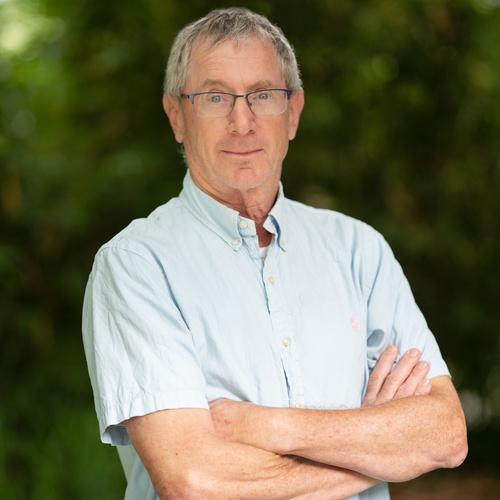
Our oceans are acidifying due to excess CO2 from human-caused emissions These emissions come especially from power generation and transportation but also from manufacturing, farming, and other activities Climate disasters only intensify the problem, as when wildfires trigger the release of carbon that was stored in burning trees
CO2 has always made its way from the atmosphere into the ocean as part of Earth’s water cycle But human activities are pumping more CO2 into the air than the ocean has calcium carbonate to process As a result calcium carbonate levels are falling and the acidity of the ocean is rising.
The increasing acidity, in turn, is damaging coral reefs and harming animals that use the ocean ’ s calcium carbonate to build their protective shells
“People care about corals for their beauty, but these organisms are also crucial to biodiversity and sustaining the populations of fish and other marine life that live in and among the coral communities,” Berelson says
As Berelson’s work on carbon capture continues, he’ll be conducting larger-scale tests on the safety of sequestering the captured and modified CO2 at sea Ultimately, both he and Adkins hope the
technology and process they’ve developed can be used to help cut emissions from industries such as shipping, a major sector of California’s economy
“Behind every potential solution for a more sustainable world lies a story of hard work and collaboration ” USC President Carol L Folt says “This promising research to reduce carbon emissions between USC and Caltech will help us all achieve a more sustainable future starting right here in Southern California
While Berelson is looking to stop ocean acidification at the source, Carly Kenkel is seeking a way to diminish the effects of another major ocean issue: rising temperatures She studies coral evolution and is working to identify the traits that may make certain corals more resistant to the stresses caused by a warming ocean
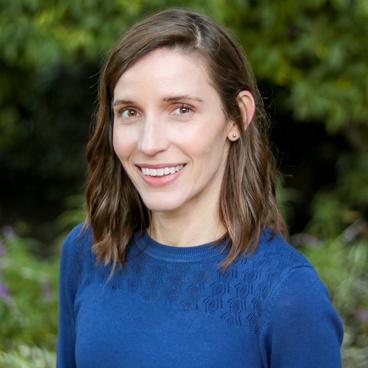
As CO2 builds up in our atmosphere, it creates an envelope effect around the planet trapping heat close to the Earth. As a result, the world’s temperatures are warming overall, and we are experiencing an increasing number of record-heat days per year
If you ’ ve ever walked past a pond or river and felt the air around you suddenly grow cooler you ’ ve experienced the heat-sink effect that large bodies of water have on the air around them The ocean works the same way, as its cooler surface temperatures draw in ambient heat But so much heat is now flowing into the ocean that its overall temperature is
rising - in some cases, beyond what marine organisms can bear
This is the case with corals, which get much of their nourishment and vibrant colors from symbiotic algae that live inside their bodies The algae can only tolerate a specific temperature range and the heat is literally killing them When they die the corals expel them and turn white, or bleach
Corals can t survive long without their algae, so bleaching is often a prelude to coral death And as ocean warming has intensified, these bleaching events have become more widespread.
“Scientists have been studying reefs to learn about coral biology for more than a century now, but widespread bleaching wasn’t observed until the 1980s Since then mass bleaching events have become more frequent and much more severe, ” Kenkel says
This is where Kenkel and her lab come in They transplant healthy corals into the seabed in the Caribbean Ocean, check on transplants from previous years and take photos that can be stitched together into 3D models of the growing corals
Back in Los Angeles, Kenkel and her students use the 3D models to take measurements of various coral traits: characteristics such as color height thickness of branches and more They use this information, along with genetic sequencing and environmental data, to understand how each coral’s traits are produced and whether those characteristics might be aiding the coral’s resistance to heat and other environmental effects
When the lab identifies corals that appear to have a higher tolerance for heat, they transplant specimens from those corals to test whether heat tolerance is retained across environments and generations In a recent study Kenkel and her co-authors were surprised to discover that the offspring of more heat-tolerant coral may actually be less heat-tolerant than their parents - an important consideration for conservationists who are planning reef restoration projects
Kenkel recently received a Wrigley Institute Faculty Innovation Award to expand her research to Indonesia, where Ph.D. student Adib Mustofa is studying the country’s Coral Triangle The new project got off the ground just in time: last summer, a record-setting warming event wiped out Kenkel’s entire population of study specimens in the Caribbean

Wrigley Institute Graduate Fellow and Kenkel lab PhD student Adib Mustofa takes coral samples in Indonesia (Photo courtesy of Adib Mustofa)
The setback, however, has only increased Kenkel’s determination and proven the urgency of finding solutions to ocean warming specifically and climate change as a whole
“Reefs provide so many essential services: they’re biodiversity hotspots, sources of new medicines, natural breakwaters that protect coastal communities, and major economic hubs for tourism and small fisheries,” Kenkel says “My lab is working toward solutions to help reefs hang on but we need everyone ’ s support to limit fossil-fuel emissions. We cannot afford to lose coral reefs ”
Vanessa Codilla, Paul McQuiston, Nick Neumann, Nina Raffio, and Kathryn Royster contributed reporting to this story The research in this story has additionally been supported by Wrigley Institute Graduate Fellowships, by the REU program funded under National Science Foundation grant No 1852220, and by a Zinsmeyer Undergraduate Research Fellowship
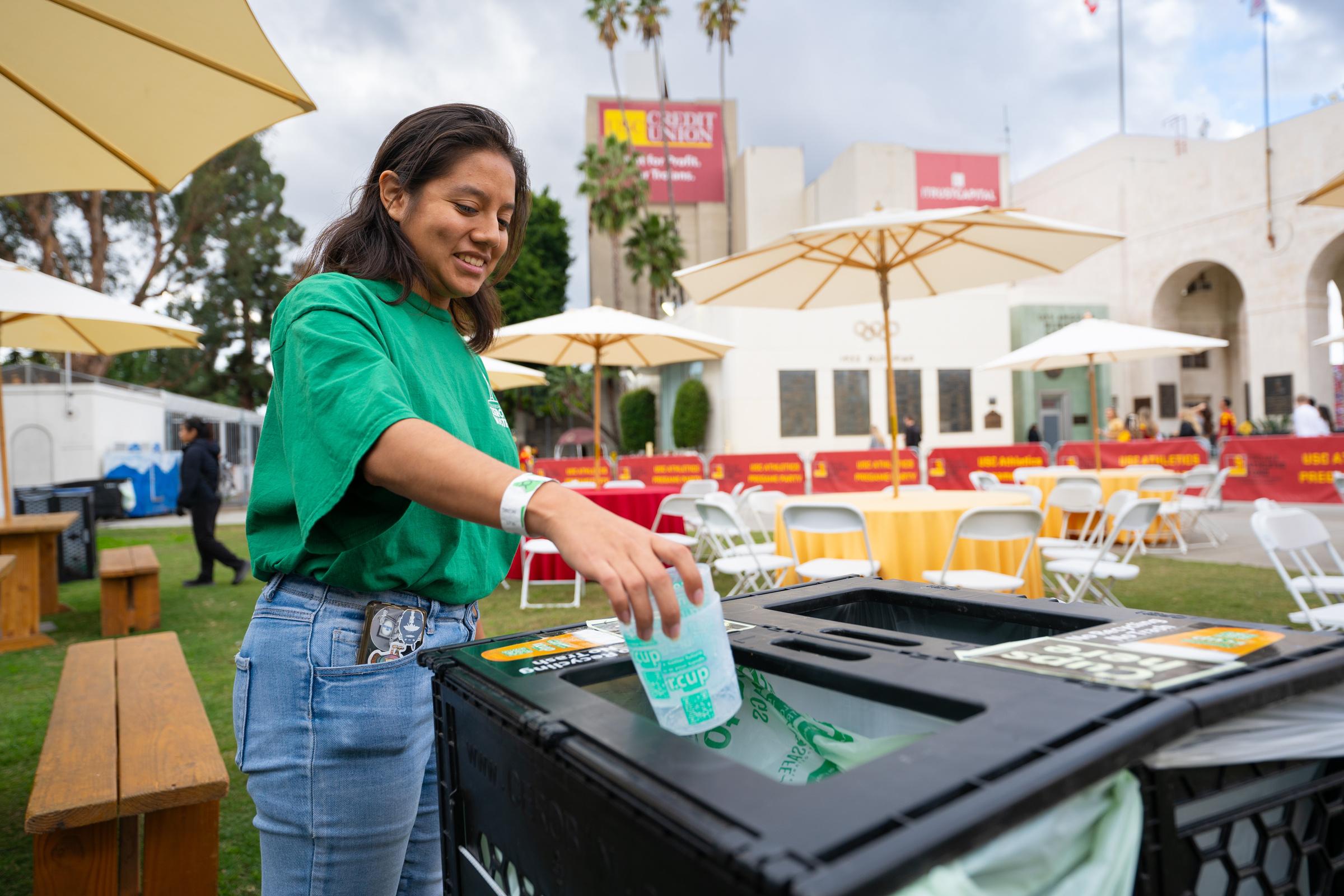
An environmental studies student helps with waste sorting at the historic Los Angeles Memorial Coliseum The Coliseum, which is operated by USC and celebrated its 100th birthday in 2023, has implemented a number of sustainability measures to help reduce the environmental footprint of events held there Led by Associate Professor (Teaching) of Environmental Studies Monalisa Chatterjee students volunteered at the Coliseum in order to learn firsthand about the operational challenges and logistics associated with conducting zero-waste events Learn more about the students’ experience at bit ly/sustainable-coliseum (Photo: Nick Neumann/USC Wrigley Institute)
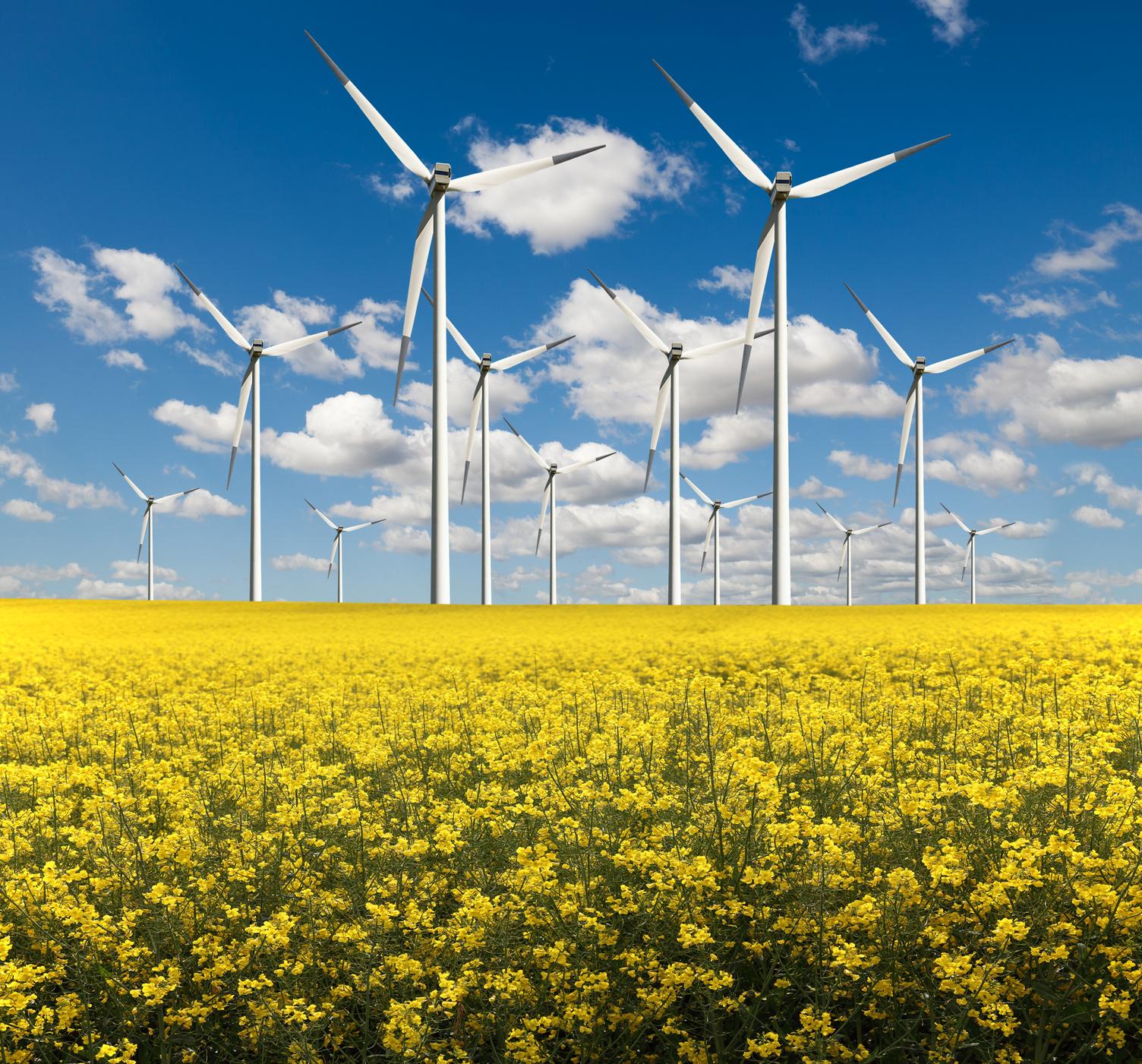 By Kathryn Royster
By Kathryn Royster
The Wrigley Institute (WIES) has launched its first standalone graduate program a Master of Sustainability Management (MSM) degree The program is offered through USC Dornsife College of Letters, Arts and Sciences and USC Online the university’s industry-leading graduate education platform tailored to the needs of full-time workers
“Most businesses have moved away from thinking about sustainability as a nice-tohave and embraced the fact that it’s essential to longterm competitiveness and profitability,” says Wrigley Institute Director Joe Árvai “But these businesses are struggling to find talented employees with advanced training in sustainability to fill key roles Our Master of
Sustainability Management was designed to address that challenge ”
The rising need for workers with sustainability skills (sometimes called green skills) is quickly outpacing supply In fact, the share of jobs requiring green skills is growing at double the rate of green talent in the workforce And as climate change continues to impact almost every aspect of organizations – from supply chains to insurance needs energy costs product design and more – the demand for sustainability-focused leaders in every sector is only going to increase
To fill the gap WIES’s MSM program is designed to help participants incorporate sustainability principles into their jobs, regardless of their role within an organization
“Most master of sustainability programs focus on training individuals to be effective as part of a dedicated sustainability team. The MSM program ’ s mantra of ‘lead from wherever you are in the organization’ is unique,” says John Viera, executive in residence at the University of Michigan’s Erb Institute for Global Sustainable Enterprise and former global director of sustainability and vehicle environmental matters for Ford Motor Co.
Viera served as part of a committee of industry leaders who helped the Wrigley Institute design the new MSM Their primary goal was to create a program that will equip students for rapid sustainability impact
“This is especially pertinent for a program that s tailored to full-time workers, Viera says “Their learnings will be immediately and directly useful to their current employers ”
The Wrigley Institute’s own mission is to approach environmental and sustainability issues through an interdisciplinary lens, with diversity, equity, and inclusion integrated into all aspects of the institute’s work
Accordingly the MSM program defines sustainability from a broad interdisciplinary perspective that takes into account not just business operations but also employee wellbeing and social impact Overall, the program is designed to shepherd students toward four primary learning outcomes:
Evaluate the impact of a broad range of social, environmental, economic, humanrights, and diversity issues on business and society
Integrate sustainability into an organization’s purpose strategy and operations in order to better manage risk find new business opportunities, and assure responsible governance
Develop a culture for employees to bring their whole selves to work, and thrive around shared sustainability values
Demonstrate the ability to engage with external stakeholders to incorporate their needs and perspectives into business strategy and sustainability reporting
As a fully online program, the MSM is open to students from anywhere in the U S as well as international enrollees. Participants can choose to complete the degree in either one or two years Courses address topics such as fundamentals of environmental, social, and governance (ESG) frameworks and the United Nations Sustainable Development Goals; leading organizational change for sustainability; sustainable supply chains, finance, and capital markets; the circular economy; sustainability metrics and reporting; and the intersection of sustainability and human rights
With a first cohort that roughly doubled enrollment expectations, the program is clearly serving a significant, unmet need This first class of students began the program in January 2024 and will be mentored by a diverse group of faculty coming from USC’s own roster as well as corporate nonprofit and government backgrounds
As an institute, one of our most important responsibilities is to train environmental and sustainability leaders who will go out into the world and make a difference for our planet at scale,” says Joe Árvai. “I’m very excited to open the door on this new opportunity to multiply our impact ”
Learn more about the MSM program at dornsife online usc edu/sm
Each year, the Wrigley Institute funds a cohort of Ph D students researching the environment and sustainability In recognition of the many ways environmental and sustainability issues touch every aspect of our lives and of academic endeavor, the fellowship encompasses not just the natural sciences but also the social sciences and humanities
In 2023, the institute awarded 16 Ph D students from the USC Dornsife College of Letters, Arts and Sciences, including the first fellows conducting research internationally Each fellow participated in professional development activities during the spring semester, then received a stipend to support summer research Fellows were based at USC's University Park Campus in Los Angeles at the Wrigley Marine Science Center on Catalina Island and in five other countries around the world Keep reading to learn more about some of their research
For the past century, central Vietnamese customs have been at the core of local cu and of fishers’ survival during war migrat resettlement in the United States. But cli change is threatening this way of life
Ann Tran, whose grandfather was the firs Vietnamese village to own a fishing boat, tracing the history of this fishing culture Vietnam and in U S Gulf States She’s exa how overfishing and other environmental challenges are changing long-held and p traditions, and investigating possibilities way forward that is both more sustainabl honors a treasured past
Ann was supported by the Sonosky Grad Fellowship for Environmental Sustainab Research Read more at bit ly/ann-tran Nick Neumann/WIES)

Historically Southeast Asia has borne the of climate disasters, yet it continues to re limited attention or support from the cou whose actions are contributing most to c change
Cities in the Philippines are responding t gap by pioneering locally-driven strategie managing the effects of climate change Through archival research and interviews residents, Gaea Morales is illuminating ho governments in the region translate international agreements into solutions t work for their cities
Gaea was supported by the Sonosky Gra Fellowship for Environmental Sustainab Research Read more at bit ly/gaea-mor (Photo: Nick Neumann/WIES)

You probably know that fertilizer runoff i significant source of pollution from agric But did you know that fertilizers have ano dirty environmental secret? Potassium fer which is key for crop growth, is typically m using fossil fuels
Rice Rander however is hoping to chang through his work with corn-based ethano source material for potassium fertilizer T process he’s testing would also generate hydrogen without the use of fossil fuels, m the creation of both fertilizer and fuel mo sustainable and more efficient: a true win our planet.
Rice was supported by the Sonosky Grad Fellowship for Environmental Sustainab Research Read more at bit ly/rice-rande (Photo: Nick Neumann/WIES)
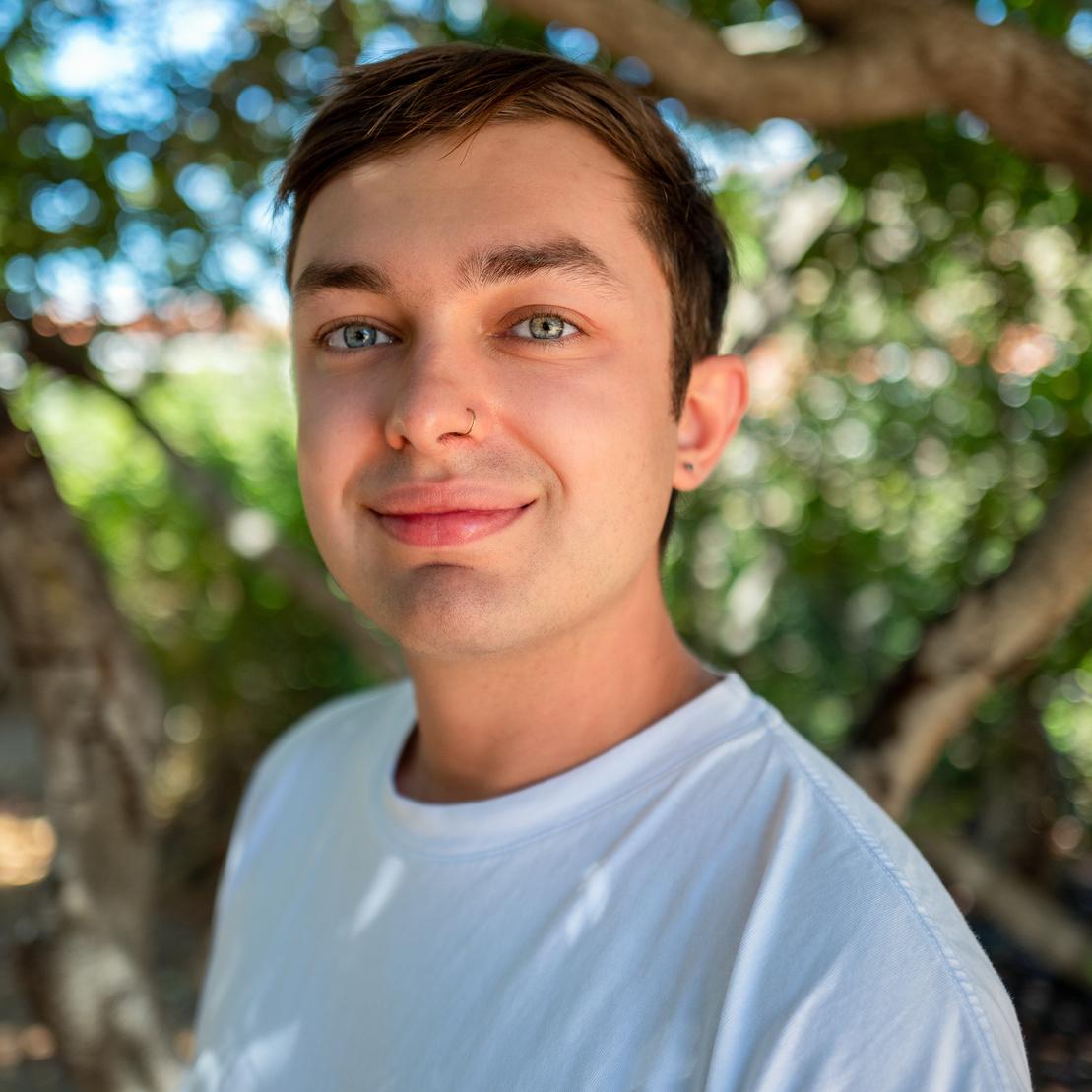
Leah Tieger grew up near the Santa Susan Lab, site of nuclear meltdowns and jet-fu dumping In 2020, she became the third children in her family to receive a cancer diagnosis The experience led her to think the legacies of environmentally contamin areas and why people choose to live near
Now, Tieger is collecting the stories of fam who, like hers, have lived in the shadow o Santa Susana Lab She hopes to illuminat people s personal experiences of risk asse environmental impact, and advocacy for cleaner future for themselves and their neighbors.
Leah was supported by the Sonosky Gra Fellowship for Environmental Sustainab Research Read more at bit ly/leah-tiege (Photo: Nick Neumann/WIES)
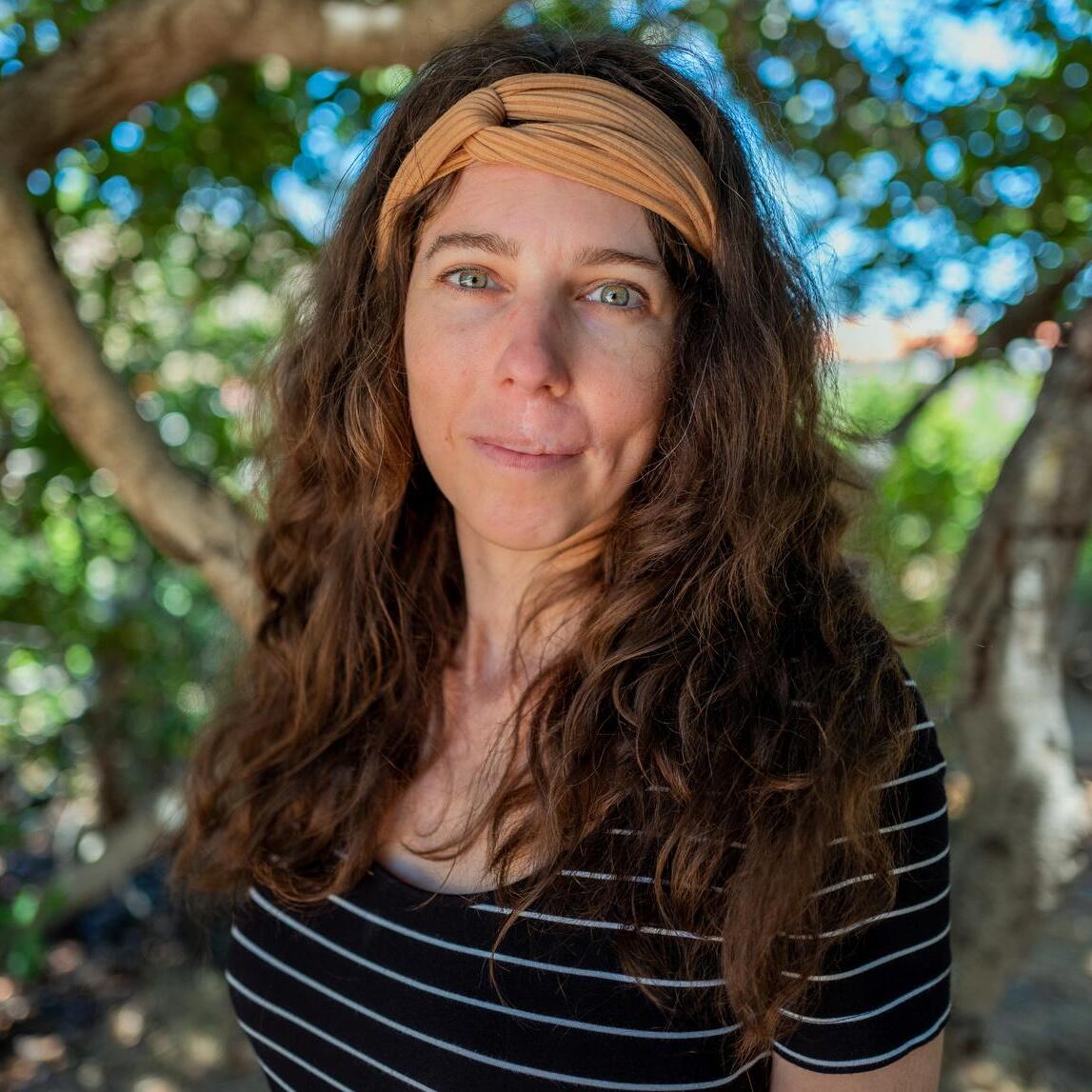
Giant kelp which grows along the Califor coastline, has tremendous potential as a carbon-neutral fuel And kelp forests are critical ocean ecosystem The very reason need kelp, however, is also the reason it s risk: humanity’s extensive use of fossil fue damaging our planet
Justin Gaffney’s research tracks the respo of kelp to environmental stressors, such a ocean warming He is working to quantify kelp s ability to process nutrients varies w changes in the seasons, water quality, an temperature Through his research we ca pinpoint risks and help kelp thrive before too late
Justin was supported by the Bertics Fellowship Read more at bit ly/justingaffney (Photo: Nick Neumann/WIES)
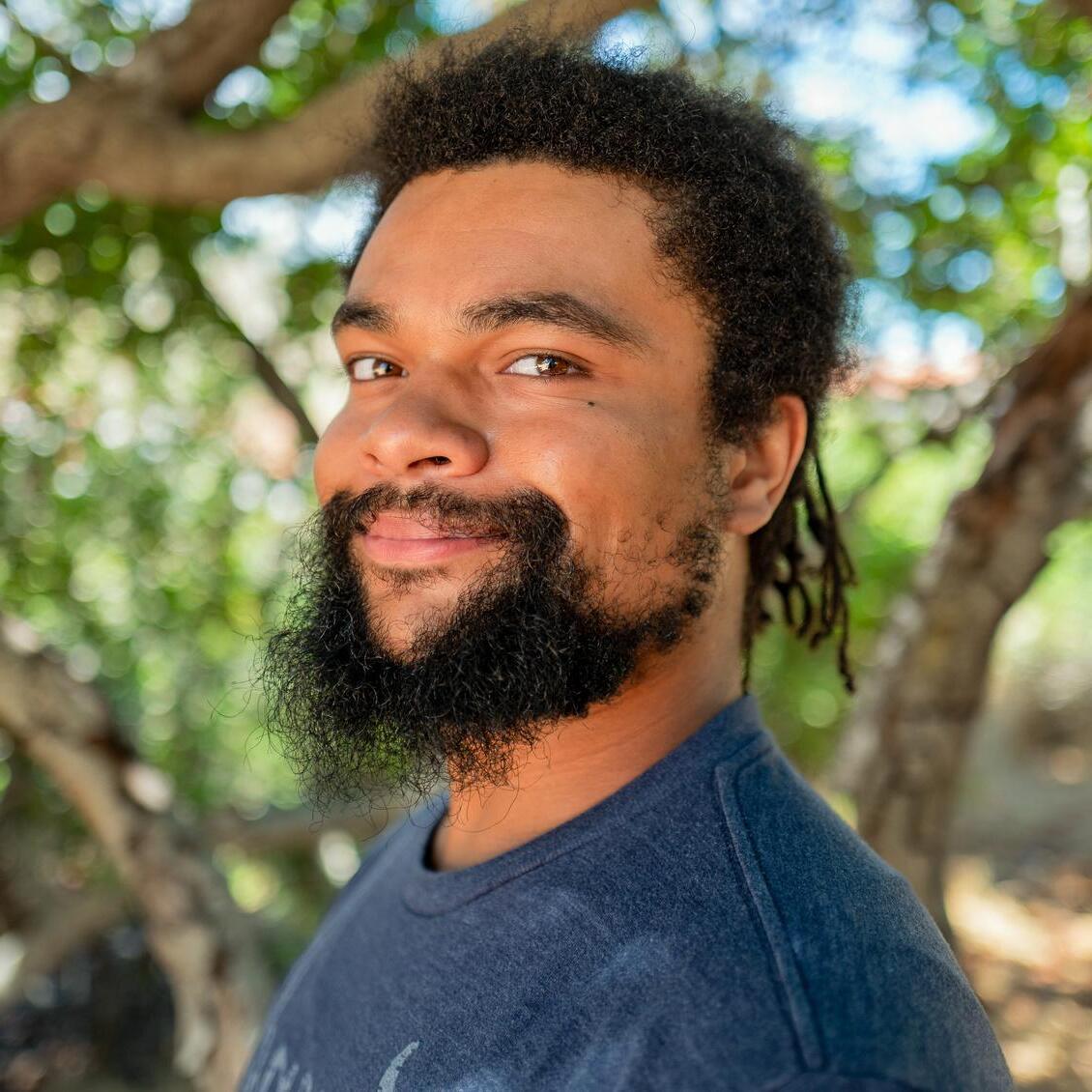
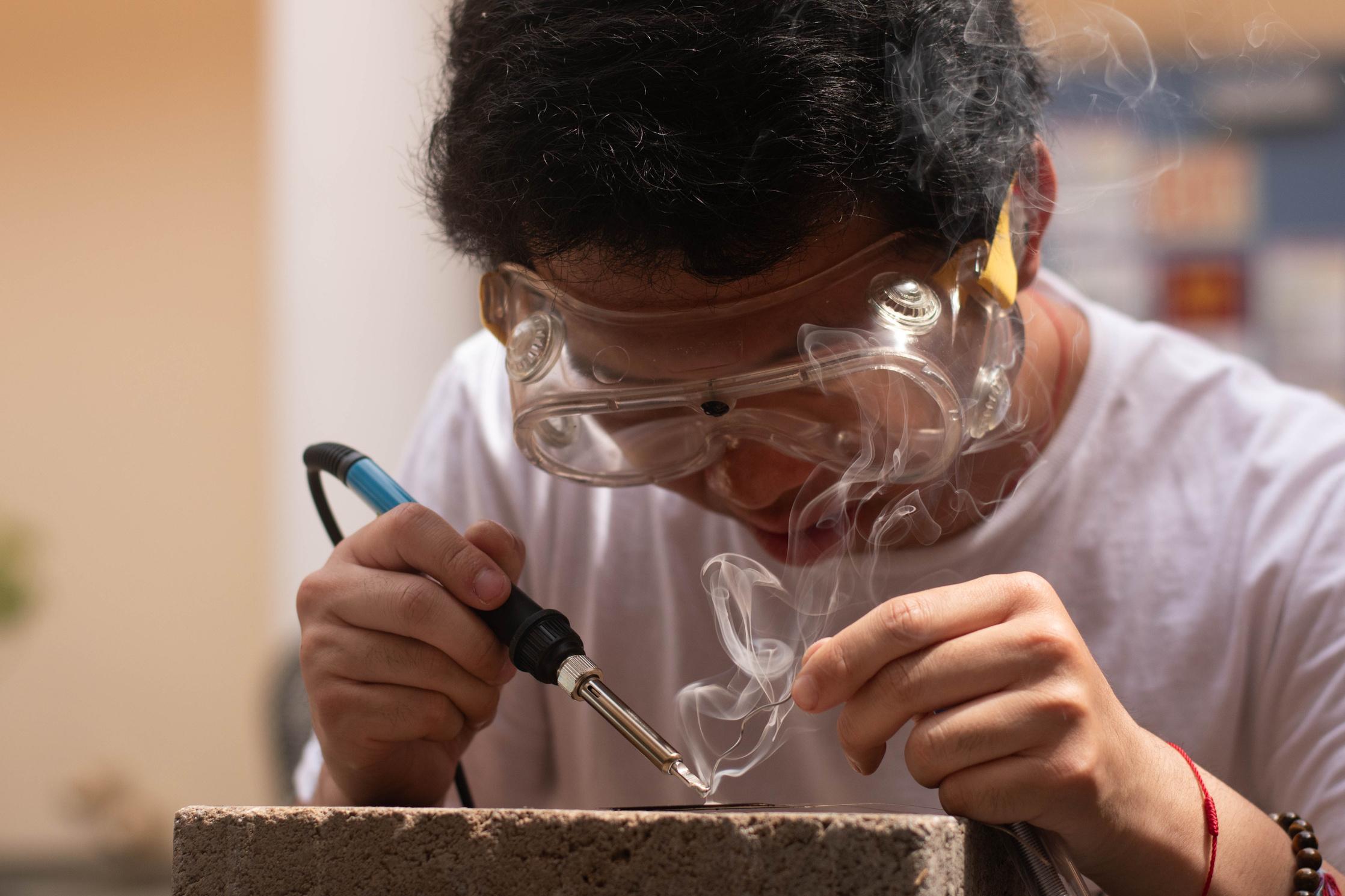
A student welds a solar cell during a lab session at the Wrigley Institute’s July Catalina Residential College Like the May Catalina Residential College, the July program is held at the Wrigley Marine Science Center on Catalina Island and gives students the opportunity to earn a semester s credit for a course in just four weeks This student was enrolled in an environmental studies course on energy and air sustainability which gave students hands-on experience in taking air samples building solar-energy equipment and other activities essential to understanding air quality issues and renewable energy (Photo: Jason Goode/USC Wrigley Institute)
The Wrigley Institute Storymakers program, which trains acad researchers in the art of storytelling, has received new funding from the Lott Foundation Awarded as $50 000 per year for th years, the grant will help the Wrigley Institute attract top-tier instructors and keep program costs low for fellows
“It s crucial that we move environmental and sustainability research out of the lab and into the hearts and minds of the public This grant helps sustain a uniquely effective program a enables us to continue recruiting a diverse cohort of fellows ” Wrigley Institute Director Joe Árvai
Storymakers fellows spend a week at the Wrigley Marine Scien Center on Catalina Island, where they learn from award-winnin instructors and build relationships with like-minded peers Th program also connects fellows with industry professionals who help them complete their creative projects
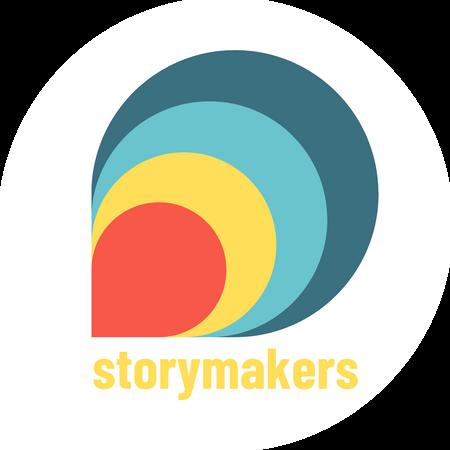
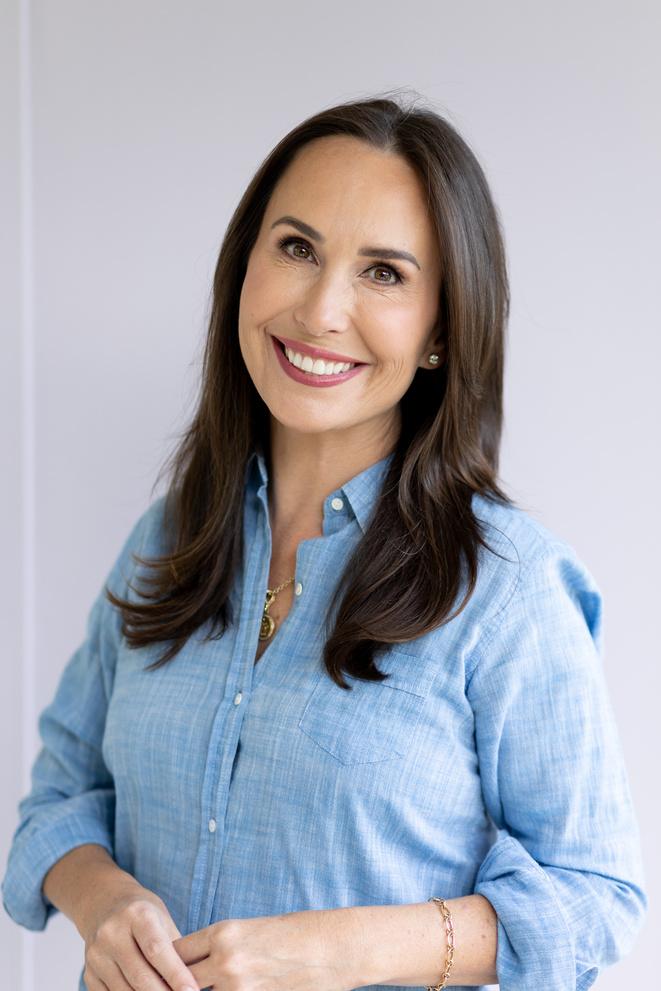 Allison Agsten
Allison Agsten
Issues related to the environment and sustainability affect every one of us, and they touch every aspect of our lives For that reason, the Wrigley Institute has expanded its approach to include art projects and experiences that elevate novel solutions and diverse voices in the fight against climate change
Allison Agsten, hired as the institute’s first art curator in 2023, is also the director of USC Annenberg’s Center for Climate Journalism and Communications She previously worked at the L A County Art Museum and the Hammer Museum
So far Agsten has guided the creation of a photojournalism series on Angelenos’ experiences with extreme heat and brought renowned artist Carolina Caycedo’s work to Climate Forward
"Behavior change around climate will require more than facts alone,” Agsten says “Artists show us that other ways and other worlds are possible often considering the same issues as scientists but with approaches that tap into emotion and imagination.”
Water has always played a prominent role in the life of A Sanchez, who grew up in a region of Ecuador that avera inches of rainfall per year
The always-green surroundings gave Sanchez a lifelong the environment and he brought his passion for the pla when he joined the Wrigley Institute’s Environmental St Program (ENST) New to ENST as a teaching postdoc in 2 became the program ’ s newest faculty member in fall 20
Sanchez knew from his undergraduate years that that h to be an environmental researcher A project studying g the Andes pointed him specifically to hydrology or the how water moves along and below the Earth’s surface W a teaching assistant in the University of Arizona’s Spanis department while earning his Ph D , he also realized he love for the humanities and for teaching
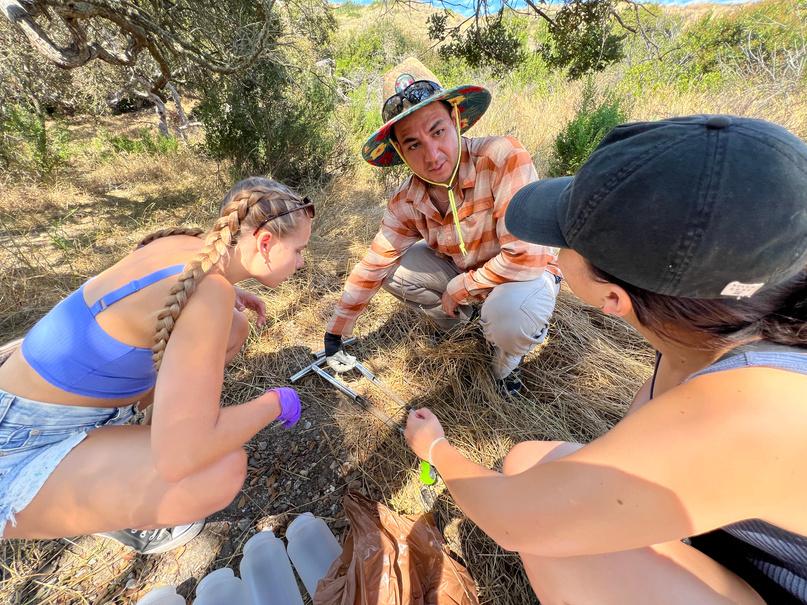
Those interests made him a natural fit for ENST an interdisciplinary program that focuses on training undergraduate students His first project involved revamping the program ’ s course on water and soil sustainability to incorporate more handson research activities
“Knowing that there are young people who are curious and want to embrace that path [of environmental research] brings me hope knowing that I’m going to be part of the mentoring group that’s going to help the future as we answer these big questions we have about climate and our environment,” Sanchez says
Wrigley Institute-affiliated faculty have been recognized by USC as leaders in sustainability research through the President’s Sustainability Initiative Awards Program This program provides seed funding and support for researchers as they apply for highly competitive federal grants
In 2023, nine of the program ’ s 15 recipients were faculty affiliates of the institute, and six were current or previous Wrigley Institute Faculty Innovation Award winners Seven of the nine were awarded for Wrigley Institute-sponsored research projects
Honorees included:
Matthew Kahn and Robert Metcalfe (with Paulina Oliva; studying the economics of climate change adaptation)
William Berelson and Kelly Sanders (studying air quality in Los Angeles neighborhoods)
Megan Fieser (with Barry Thompson; studying the upcycling of PVC)
Andrew Gracey and Sergey Nuzhdin (studying endangered sunflower sea stars)
Clay Wang and Travis Williams (studying the conversion of waste plastics into medicines)
1,282
ENVIRONMENTAL STUDIES STUDENTS & ALUMNI
139 STAFF & AFFILIATED FACULTY
138 INTERNSHIPS, FELLOWSHIPS, & EXPERIENTIAL LEARNING AWARDS
606,300
SOCIAL MEDIA IMPRESSIONS
2,403 VISITORS TO WMSC
1,162 EVENT ATTENDEES
The activities of the USC Wrigley Institute for Environment and Sustainability would not be possible without the support of our many donors Our deepest thanks to every one of you who has given to our mission over the past year Your generosity enables us to continue our efforts to create a more sustainable and environmentally just future for our planet and all who live on it
If you would like to support any of the programs mentioned in this issue, or give to our general fund, please contact Jessica Dutton at jmdutton@usc edu
The USC Wrigley Institute for Environment and Sustainability is housed within Dornsife College of Letters, Arts and Sciences and encompasses several divisions
The Wrigley Marine Science Center located on Santa Catalina Island is our satellite campus that uniquely bridges the island's pristine ecosystem and the conurbation of Los Angeles.
The USC Dornsife Environmental Studies Program is our primary education arm and houses undergraduate and master's degree programs in environmental studies
USC Sea Grant provides peer-reviewed science to policymakers and collaborates with policymakers, K-12 schools, and other stakeholders to solve the problems of the urban ocean
Our Research Centers support USC faculty postdocs and students as they conduct solutionsfocused investigations into pressing environmental and sustainability challenges
Our Engagement Center encompasses events, key outreach programs, and our marketing and communications efforts
Dr. Joe Árvai, Director
Dr Jessica Dutton Executive Director
Dr John Heidelberg Director Wrigley Marine Science Center
Dr Karla Heidelberg, Director, USC Sea Grant
Karl Huggins, Executive Director
Eun-Jung Julie Aguilar
Larry Harris
Dr Jill Sohm, Director, Environmental Studies Program
Sean Conner, Associate Director of Operations, WMSC
Holly Nielson Associate Director for Business Strategy & Finance
Kathryn Royster, Assistant Director for Public Communications
Katie Chvostal
Shai Coronado
Lauren Geving
Alex Montances
Art Mireles
Carl Oberg
Randy Phelps
Vanessa Codilla
Nick Neumann
Dr Scott Applebaum
Dr Victoria Campbell-Árvai
Dr Monalisa Chatterjee
Dr Sean Fraga
Dr. Shannon Gibson
Dr David W Ginsburg
Dr Victoria Petryshyn
Dr Andres Sanchez
Dr Josh West
Dr Yael Wolinsky-Nahmias
Support Staff
Mich Bollinger
Natalie Inouye
Kennith Cameron
Jake Carmona
Amy Costa
April Harrison
Maribel Murguia
Jose Platas
Fernando Gutierrez
Tom Russo
Sam Majeed
Allison Agsten
Amber Brown
Lauren Czarnecki Oudin
Dr Diane Kim
Meghan MacGregor
Brittany Martinez
Hannah Maryanski Kiszla
Matthew Ragan
Marcela Riddick
Lorraine Sadler
Victoria Sperow
Phyllis Grifman, Executive Director
Dr Amalia Almada
Rachel Darling
Ruth Dudas
Dane Lazarus
Maria Madrigal
Leah Shore
Charlotte Stevenson
Juan Carlos Aguilar
Geoffrey Creighton
Mariluz "Lucy" Fornias
Troy Gunderson
Trevor Oudin
Hanna Reed
Philip Hagenah, Co-chair
Todd Bauer, Co-chair
Alison Wrigley Rusack
Terry Adams
Sevag Ajemian
Anjini Desai
Brock Dewey
Rod Diefendorf
Alexandra Jameson
Sam King
Calen Offield
Chase Offield
Maria Pellegrini
John Rego
Diane Sonosky Montgomery
David Thomas
Denise Verret
Julie Wrigley
Daniel Zinsmeyer

Members of the Wrigley Institute team at Two Harbors, Catalina Island, during a 2024 team appreciation event (Photo: Nick Neumann/WIES)
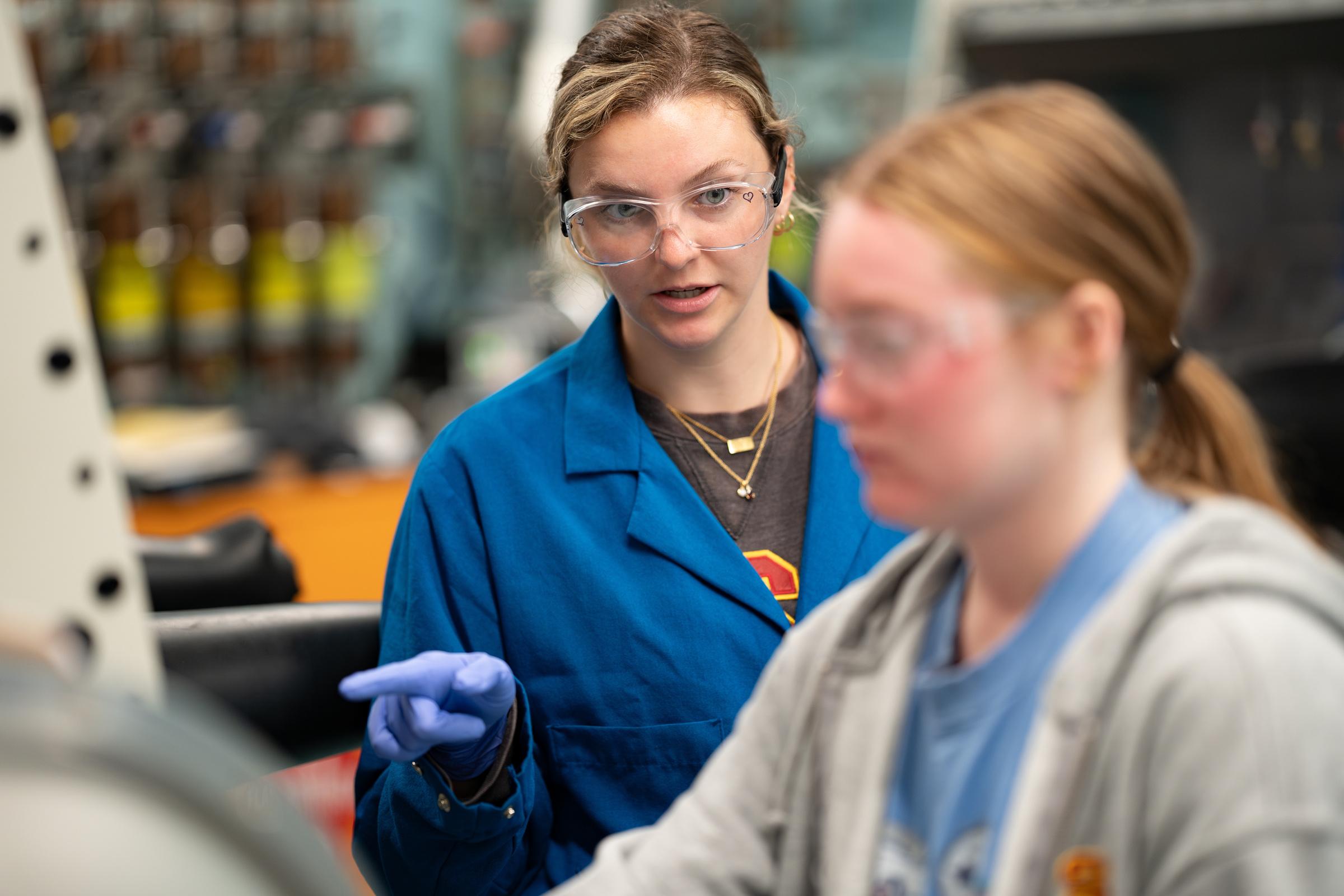
guides an undergraduate student through an experiment in the lab of Wrigley Institute faculty affiliate and Gabilan Assistant Professor of Chemistry Megan Fieser WIES helps support the Fieser Lab’s investigations into novel ways to break down and reuse hard-to-recycle plastics such as PVC (polyvinyl chloride) Bush and Fieser, like many Wrigley Institute graduate fellows and faculty affiliates, mentor undergraduate students as part of their work This creates meaningful research experiences that influence many younger students to dedicate their careers to environmental and sustainability issues. (Photo: Nick Neumann/USC Wrigley Institute)
2023 Wrigley Institute (WIES) Graduate Fellow and chemistry Ph D student Nancy Bush (left)
3454 Trousdale Parkway
CAS 200
Los Angeles, CA 90089
dornsife-wrigley.usc.edu
@uscwrigley on social media
 Scott Applebaum
Scott Applebaum